QNAP Tech Summit 2025 – All New Hardware and Software Solutions Unveiled
During Computex 2025 in Taipei, QNAP hosted its annual Tech Summit to unveil a broad array of new hardware and software solutions aimed at addressing evolving demands across creative, enterprise, and edge environments. The event marked a continued shift in QNAP’s product direction—placing greater focus on hybrid cloud integration, high-speed connectivity, and on-premises AI deployment. With an emphasis on real-time collaboration, secure multi-site operations, and scalable infrastructure, the brand introduced several next-generation NAS systems, networking components, and AI-ready platforms.
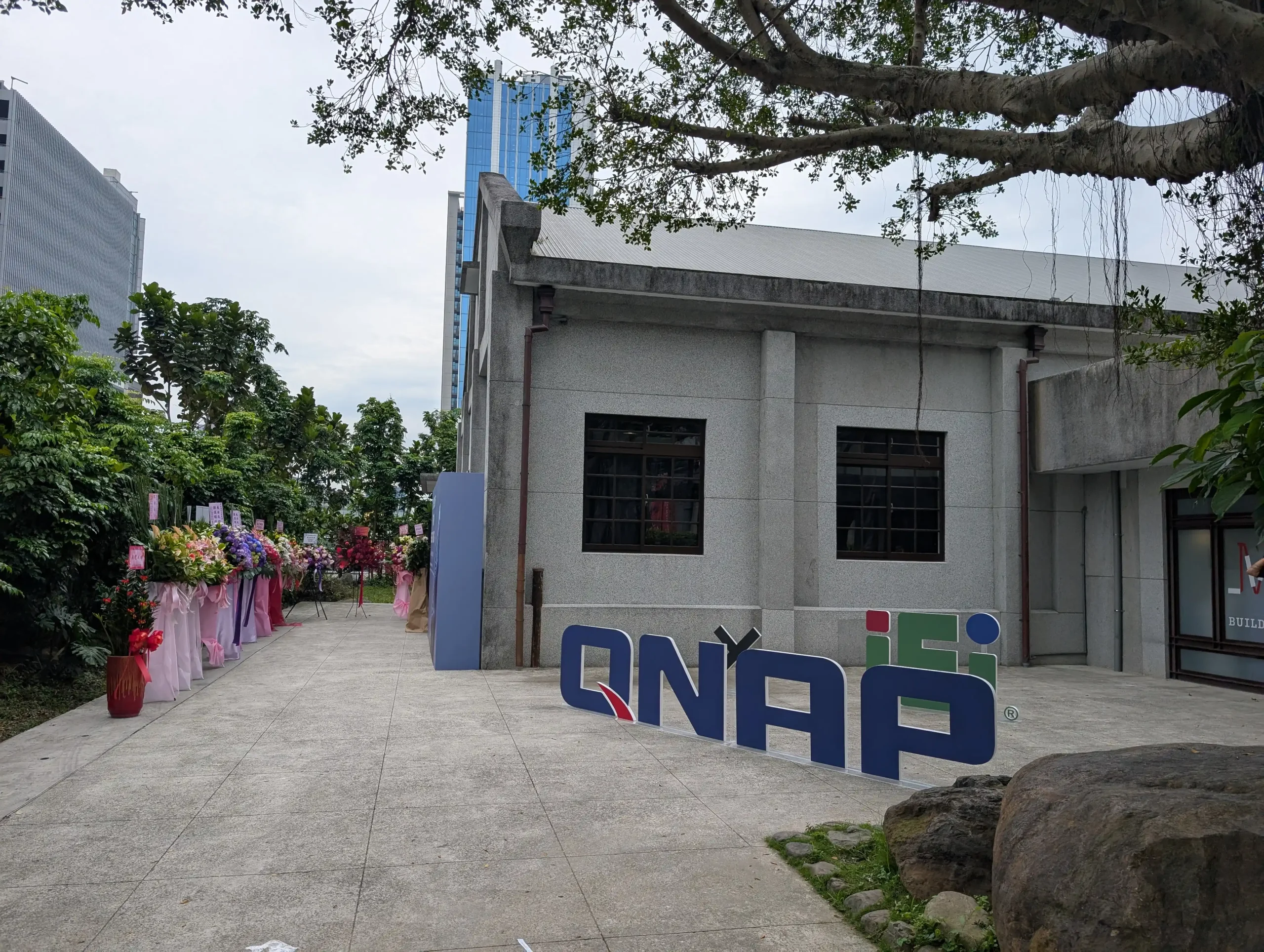
Among the standout themes were high-availability architecture with modular redundancy, scale-out storage clusters for petabyte-class expansion, Thunderbolt 5 and USB4-enabled creative workflows, and new AI capabilities integrated directly within NAS environments. Surveillance, backup automation, and cloud services also featured prominently in QNAP’s roadmap for 2025. This article provides a structured breakdown of each individual hardware product and software solution announced or demonstrated during the summit, using verified details from the live showcase and official press releases.

TVS-AIh1688ATX – Thunderbolt, AI Workloads, and Hybrid SSD/HDD Architecture
The TVS-AIh1688ATX is QNAP’s latest high-performance desktop NAS solution designed for creative professionals, AI developers, and hybrid storage environments. Powered by Intel’s 15th-generation Core Ultra processors, this system offers up to 24 cores with an integrated 13 TOPS NPU, making it one of the most compute-capable QNAP NAS systems available to date. Designed for high-throughput workloads such as video editing, AI model inference, and multi-user virtualization, the unit blends storage flexibility with modern I/O and connectivity. The TVS-AIh1688ATX features 12 x 3.5-inch SATA HDD bays and 4 x 2.5-inch U.2 NVMe SSD bays, providing tiered storage suitable for media caching, fast data ingestion, and archival. Although the M.2 slot configuration has not been officially confirmed, the design suggests focus has been placed on high-speed U.2 storage instead. Memory is expandable up to 192GB DDR5 ECC, supporting both VM-intensive and AI-enhanced environments.
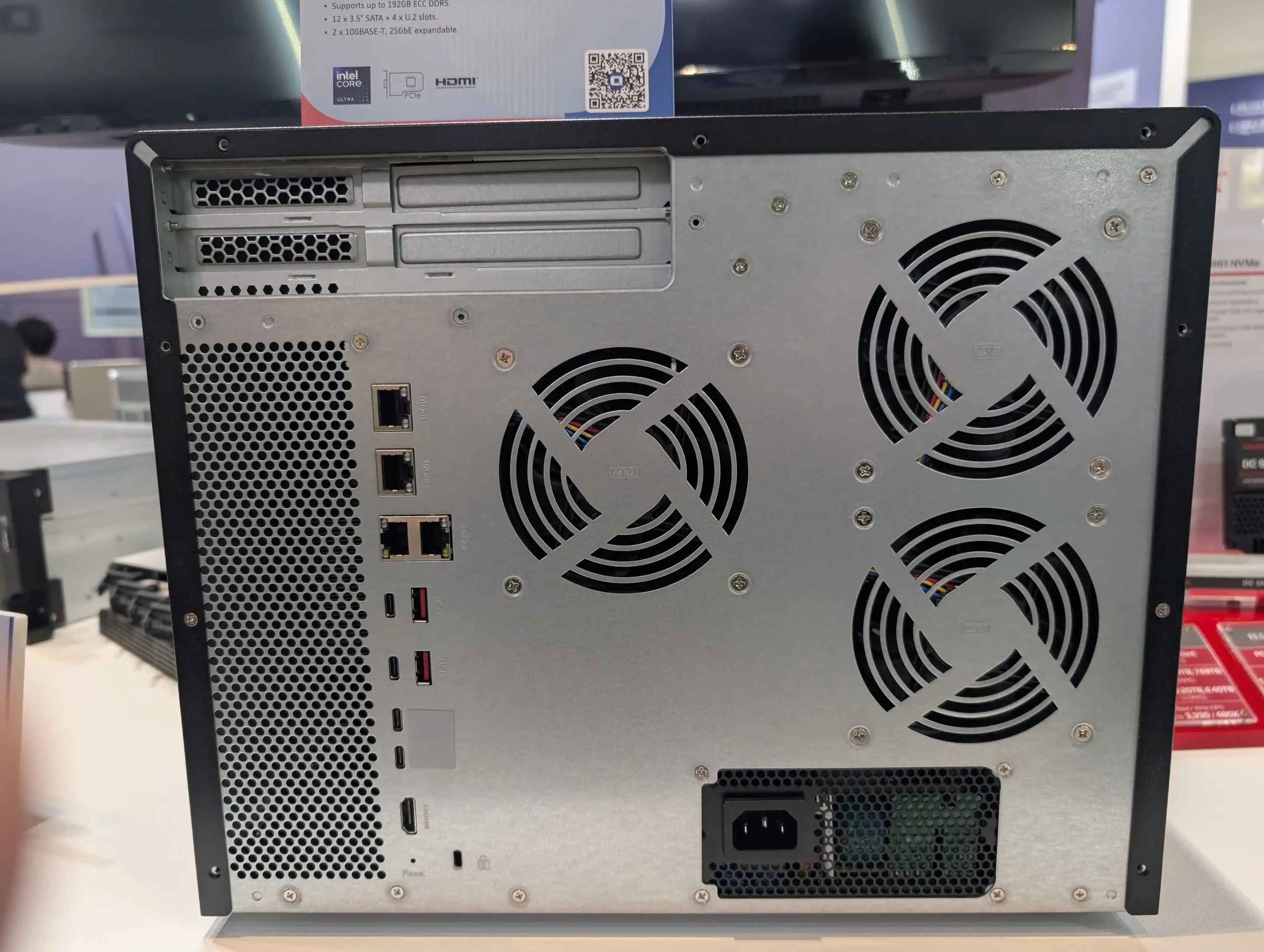
On the connectivity side, the system offers dual Thunderbolt 4 (USB4) ports built-in, with optional expansion for Thunderbolt 5 using the QXP-T52P PCIe upgrade card, which utilizes Intel’s JHL9580 controller. It includes 2 x 10GBASE-T Ethernet ports and supports 25GbE/100GbE expansion via available PCIe Gen 4 x4 slots. This makes it viable for multi-user 4K/8K content workflows, fast data offloads, and scalable network integration.
This NAS runs either QTS (EXT4) or QuTS hero (ZFS), depending on user preference, with support for ZFS features like inline compression, deduplication, and near-limitless snapshots. It is also fully compatible with FileTiers, Qsirch with AI-enhanced RAG search, myQNAPcloud One, and VM Station with GPU pass-through for AI workloads. These attributes enable it to serve both as a media production hub and localized AI platform.
| Feature | Details |
|---|---|
| CPU | Intel Core Ultra (up to 24 cores, with 13 TOPS NPU) |
| Memory | 1 x DDR5 ECC (expandable up to 192GB) |
| Drive Bays | 12 x 3.5″ SATA HDD + 4 x 2.5″ U.2 NVMe SSD |
| Thunderbolt Ports | 2 x USB4/Thunderbolt 4 (built-in), 2 x Thunderbolt 5 (optional via PCIe) |
| PCIe Expansion | Up to 3 slots (2 usable for TB5, 100GbE, or GPU options) |
| Network Ports | 2 x 10GBASE-T, optional 25GbE / 100GbE via PCIe |
| AI Acceleration | Integrated NPU, supports GPU pass-through via Virtualization Station |
| Storage Features | RAID 0/1/5/6/10, ZFS/EXT4, SnapSync, FileTiers |
| Software | QTS / QuTS hero, Qsirch AI Search, myQNAPcloud One |
| Use Cases | 4K/8K editing, local AI inference, VM hosting, media archiving |
TS-h974TX – Compact 9-Bay NAS with Thunderbolt 4 and Hybrid SSD Support
The QNAP TS-h974TX is a compact 9-bay NAS aimed at professionals requiring a balance between high-speed external connectivity, internal storage flexibility, and moderate compute performance. It features an Intel Core i3-1215U processor with 6 cores (2P + 4E) and 8 threads, capable of boosting up to 4.4GHz, making it suitable for multimedia workflows, virtualization, and SMB-level AI services.
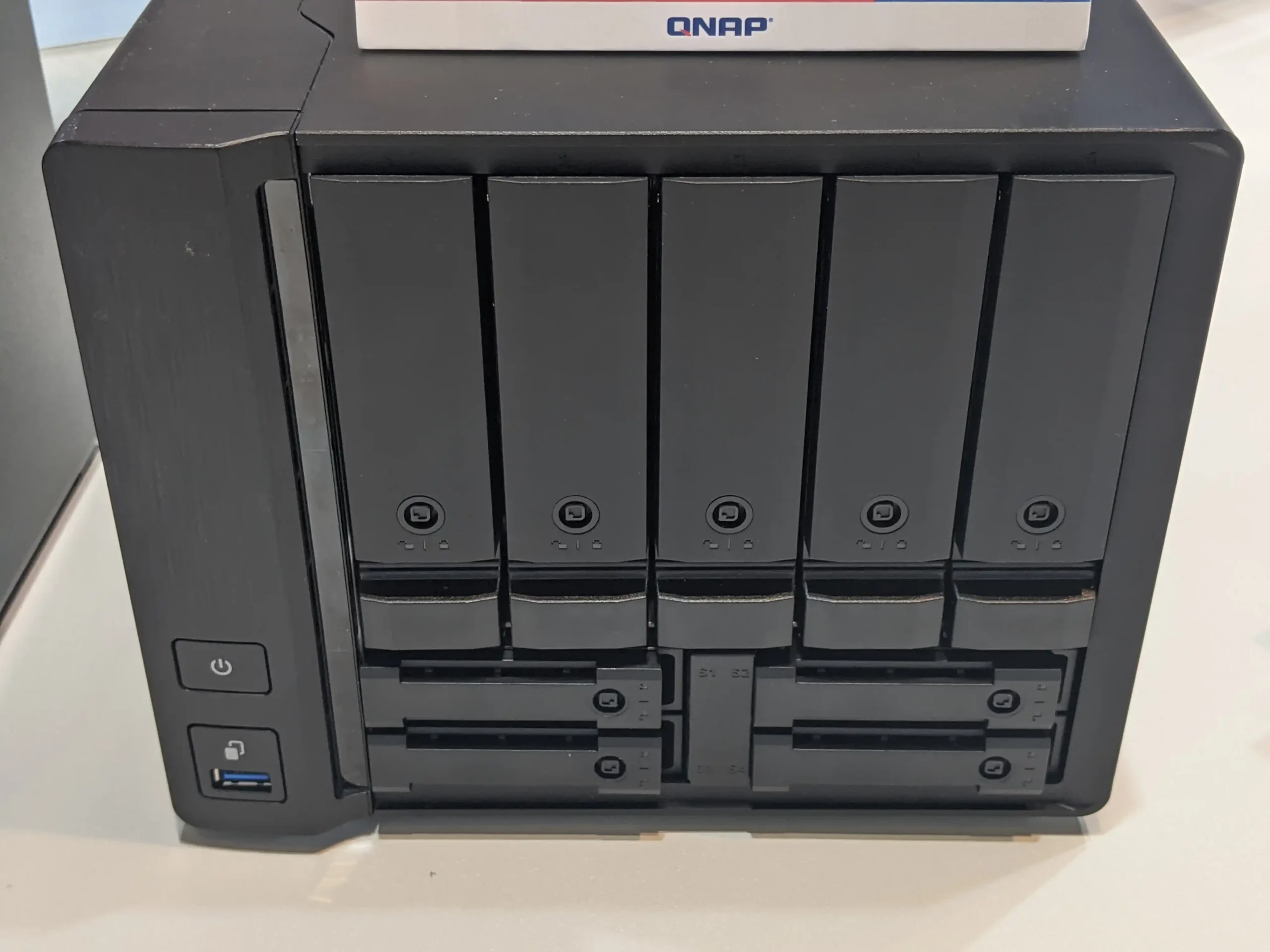
This NAS includes 5 x 3.5-inch SATA HDD bays and 4 x 2.5-inch U.2 PCIe Gen 3 x2 slots, giving users the ability to combine traditional hard drive storage with fast SSD caching or performance-tier pools. QNAP’s support for E1.S or NVMe M.2 modules in these U.2 slots also enables forward-looking upgrade paths. The TS-h974TX ships with 8GB of DDR5 memory, upgradeable to 64GB, with support for ECC where required.
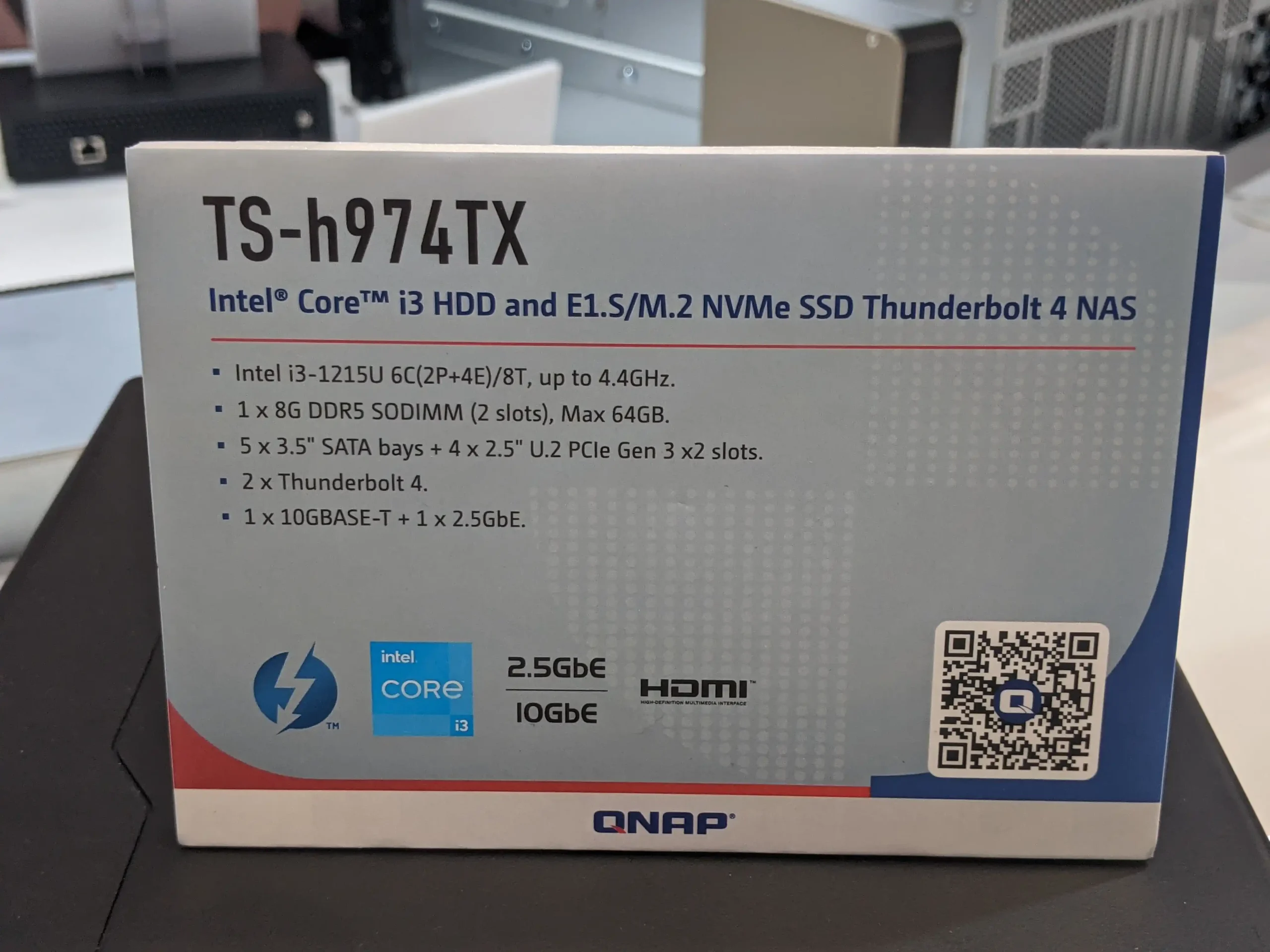
Key to the system’s appeal is its inclusion of 2 x Thunderbolt 4 ports, which allow for high-speed DAS-style access from editing workstations or integration into content creation environments. Networking options include 1 x 10GBASE-T and 1 x 2.5GbE RJ45 port, supporting link aggregation and flexible deployment scenarios.
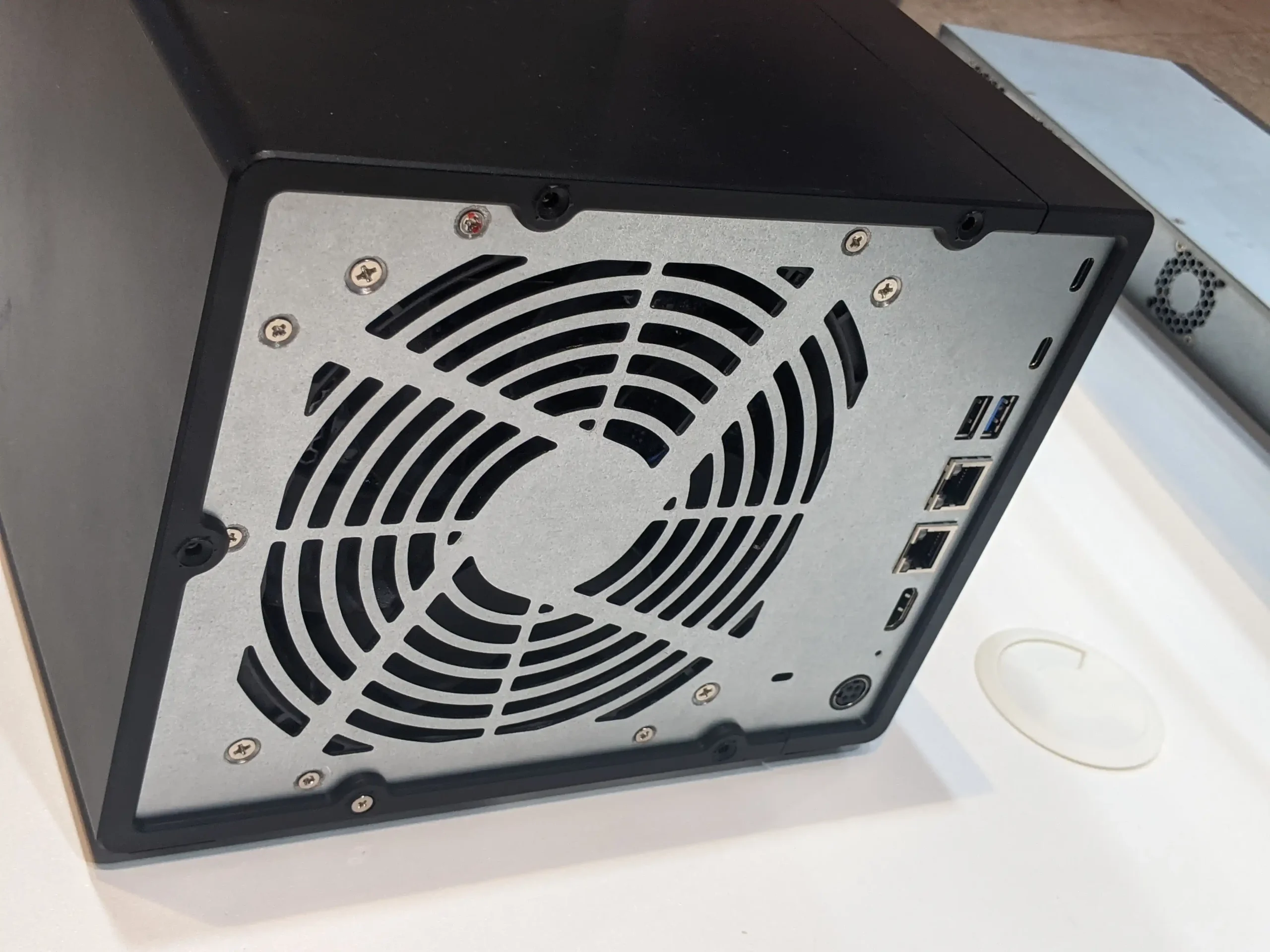
The system runs QuTS hero, taking advantage of ZFS features such as inline deduplication, compression, and SnapSync. Its form factor, combined with its I/O options and high-speed storage lanes, makes it well-suited for use in hybrid video production pipelines, post-production setups, and edge AI inference when combined with GPU-accelerated containers or VMs.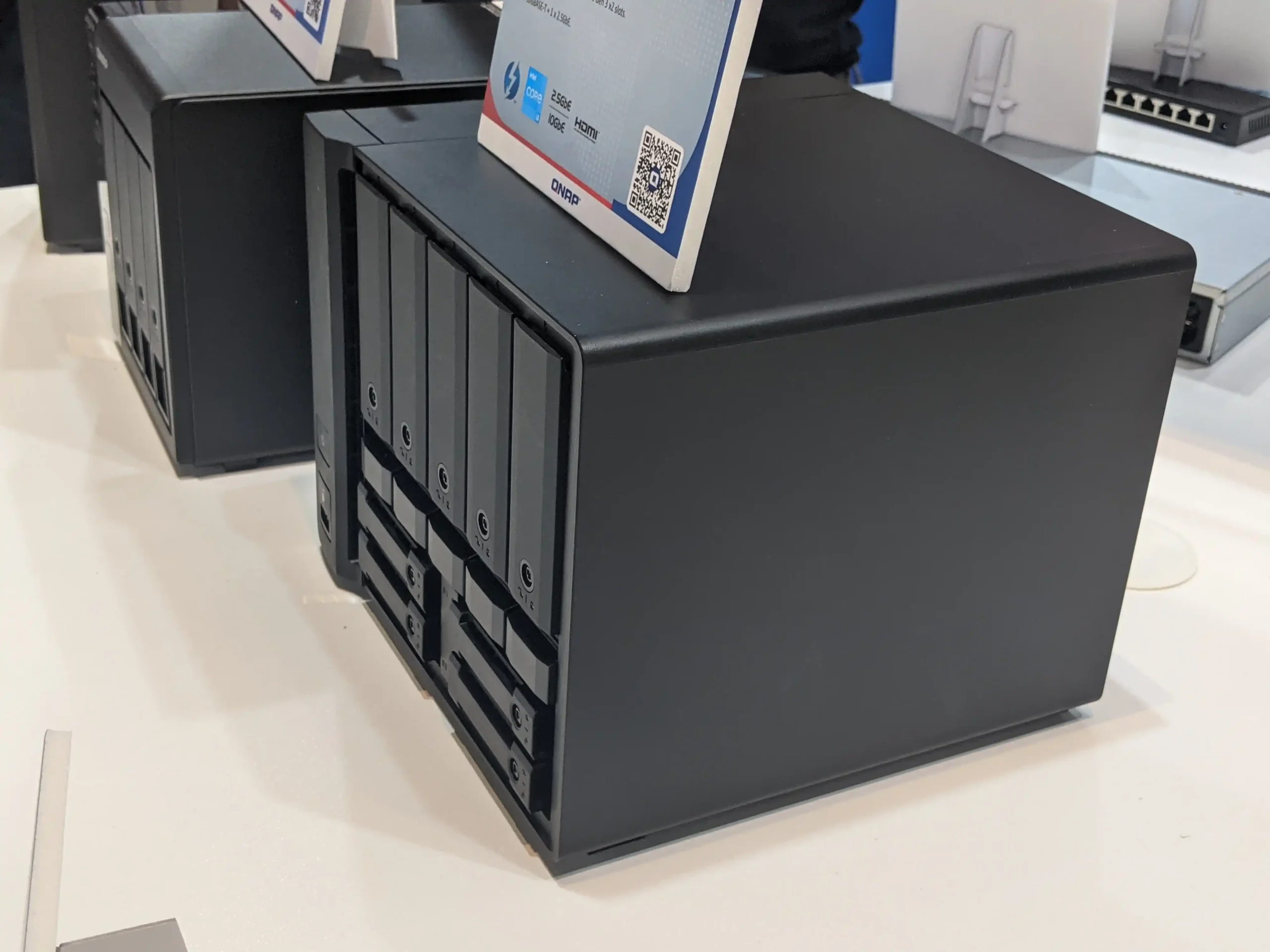
| Feature | Details |
|---|---|
| CPU | Intel Core i3-1215U (6C/8T, up to 4.4GHz) |
| Memory | 8GB DDR5 SODIMM (2 slots, up to 64GB) |
| Drive Bays | 5 x 3.5″ SATA HDD + 4 x 2.5″ U.2 PCIe Gen 3 x2 SSD |
| Thunderbolt Ports | 2 x Thunderbolt 4 |
| Network Ports | 1 x 10GBASE-T, 1 x 2.5GbE RJ45 |
| PCIe Expansion | Not specified (non-expandable unit) |
| AI/VM Support | Container Station, Virtualization Station, Qsirch AI |
| File System Support | ZFS via QuTS hero |
| Use Cases | 4K editing, SSD caching, SMB NAS, AI inference with external GPU |
ES1686dc R2 – Dual-Controller, High Availability ZFS NAS for Enterprise
The QNAP ES1686dc R2 is a 16-bay enterprise-grade NAS built for continuous uptime and operational resilience through a dual active-active controller architecture. Each controller operates independently but in parallel, handling I/O workloads simultaneously to ensure that services remain online even if one controller fails or undergoes maintenance. This makes it well-suited for deployment in industries such as finance, healthcare, and high-throughput virtualization environments where data availability is critical.
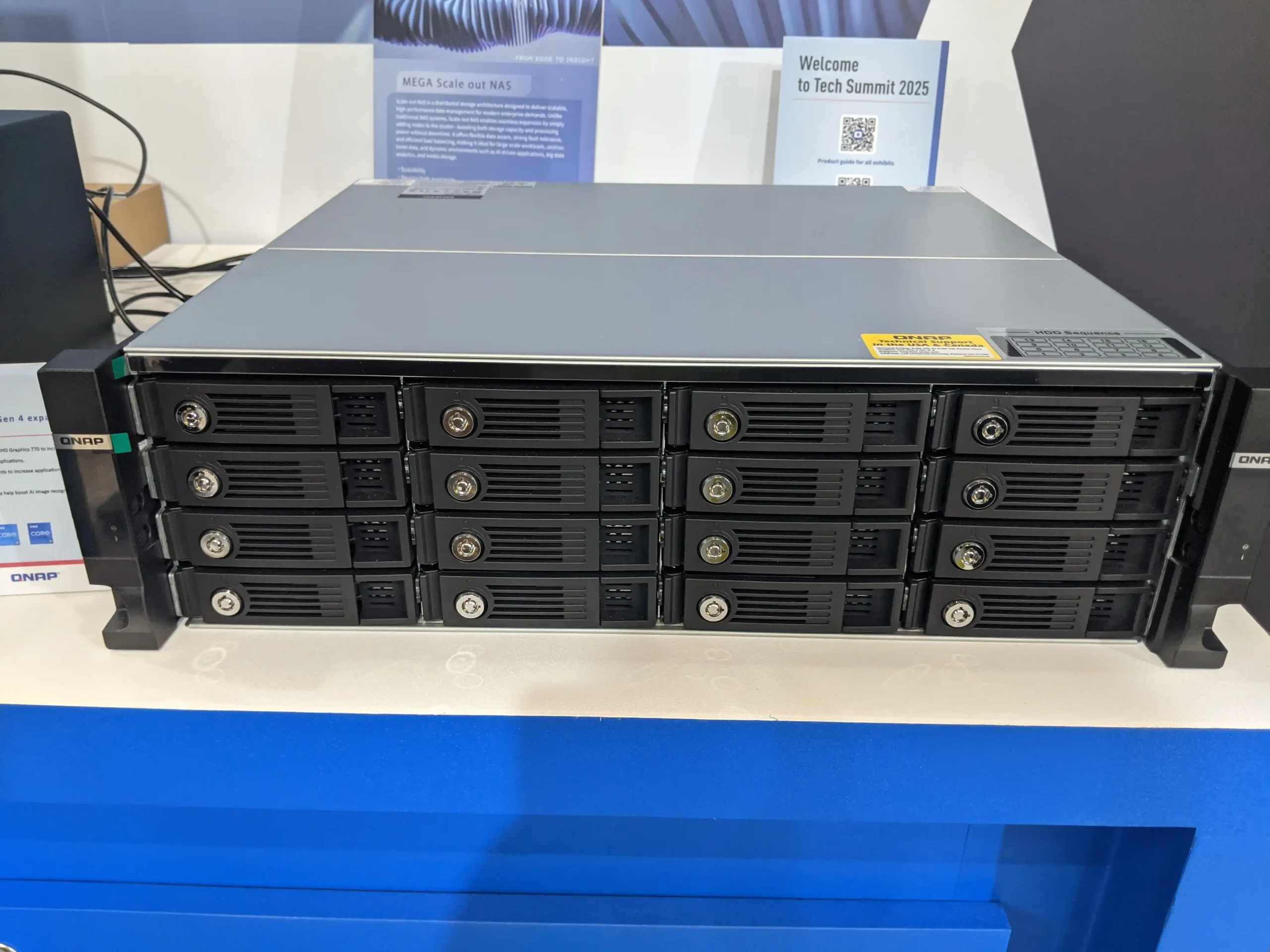
Each controller includes 4 x 10GbE SFP+ ports, allowing for high-speed link aggregation and redundant connectivity. The system also includes 2 x PCIe slots per controller, which can be used to expand the unit with additional 10GbE, 25GbE, or SAS expansion cards. Write cache integrity is protected via NVRAM modules, reducing the risk of data loss during unexpected power failures.

The ES1686dc R2 runs QuTS hero, utilizing the ZFS file system for inline deduplication, compression, and end-to-end data integrity. It supports SnapSync for real-time remote replication and near-limitless snapshots, allowing organizations to maintain strong data protection policies and disaster recovery protocols. The system is also designed to be compatible with QNAP’s L3 Lite switch series and AMIZcloud monitoring tools, enabling integration into larger scale-out architectures and hybrid network environments.
This NAS platform also benefits from a modular design—with field-replaceable PSU and controller modules, administrators can quickly restore service in the event of hardware failure without downtime or full system shutdown.
| Feature | Details |
|---|---|
| Architecture | Dual active-active controllers (modular, hot-swappable) |
| Network Ports (per controller) | 4 x 10GbE SFP+ |
| PCIe Slots (per controller) | 2 x PCIe (for 10GbE/25GbE or expansion) |
| Drive Bays | 16 x 3.5″ SAS/SATA hot-swappable bays |
| Cache Protection | NVRAM modules for write cache integrity |
| File System | ZFS (QuTS hero) |
| Key Features | SnapSync, inline deduplication, compression, near-instant failover |
| Management Tools | Guardian (health monitoring), AMIZcloud, QuLog, Qsirch AI |
| Use Cases | Mission-critical apps, HA clusters, virtualization, regulated sectors |
USB4 Network Adapters and JBOD Expansion – High-Speed I/O for Creative and Enterprise Workflows
At the QNAP Tech Summit 2025, several USB4-based hardware accessories were unveiled, aimed at enhancing the connectivity of both NAS and client systems. These include network adapters for 10GbE and 25GbE access, as well as a new 8-bay USB4 JBOD expansion enclosure for extending direct-attached storage capacity.
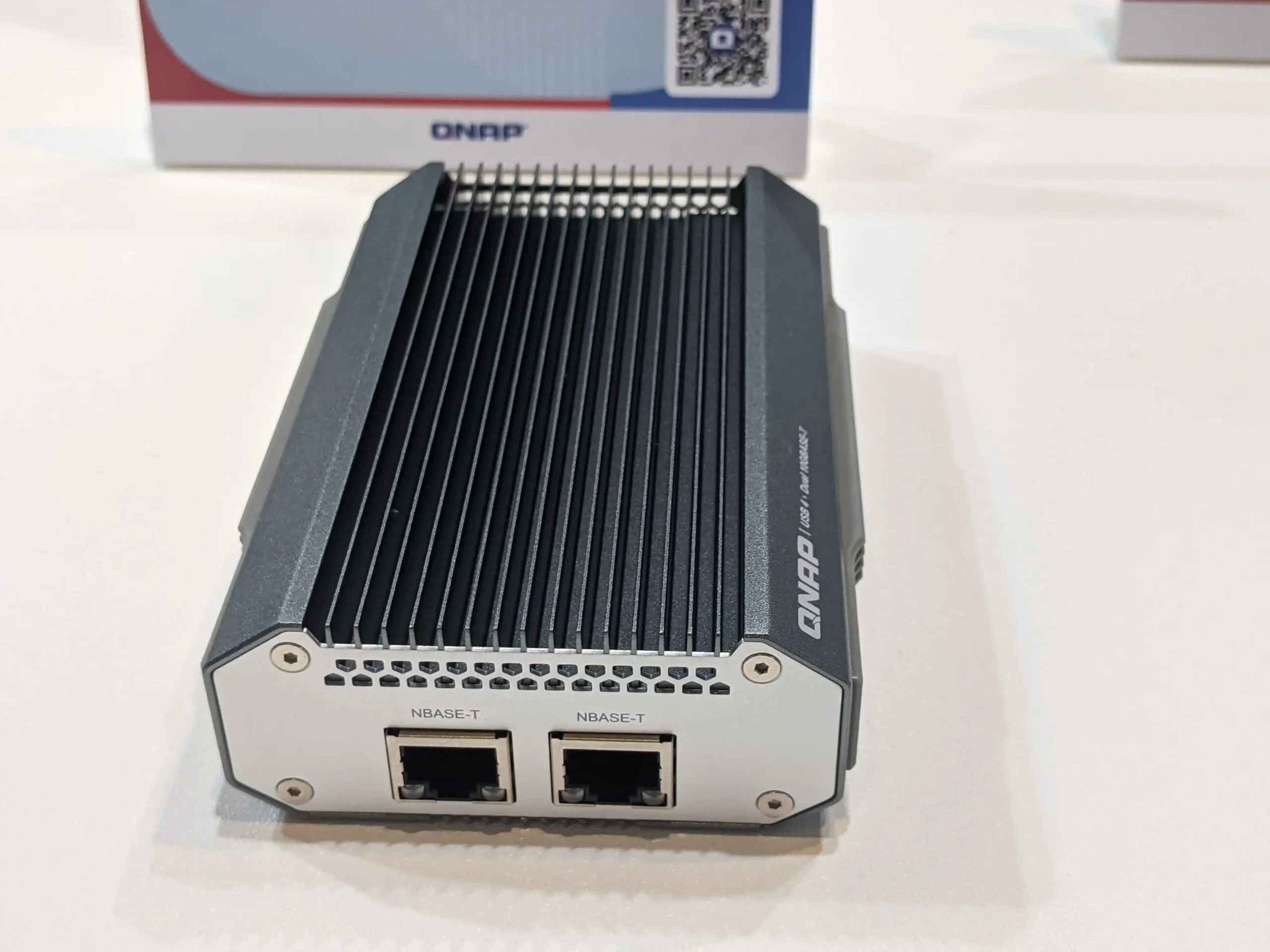
QNA-UC10G2SF – USB4 to Dual-Port 10GbE SFP+ Adapter
This fanless adapter allows any USB4-enabled host system to connect directly to high-speed SFP+ networks. It features 2 x 10GbE SFP+ ports, includes two transceivers, and connects via a USB4 Type-C cable (included). Designed for creative users and workstation environments, it enables direct 10GbE access from laptops or desktops without PCIe upgrades.
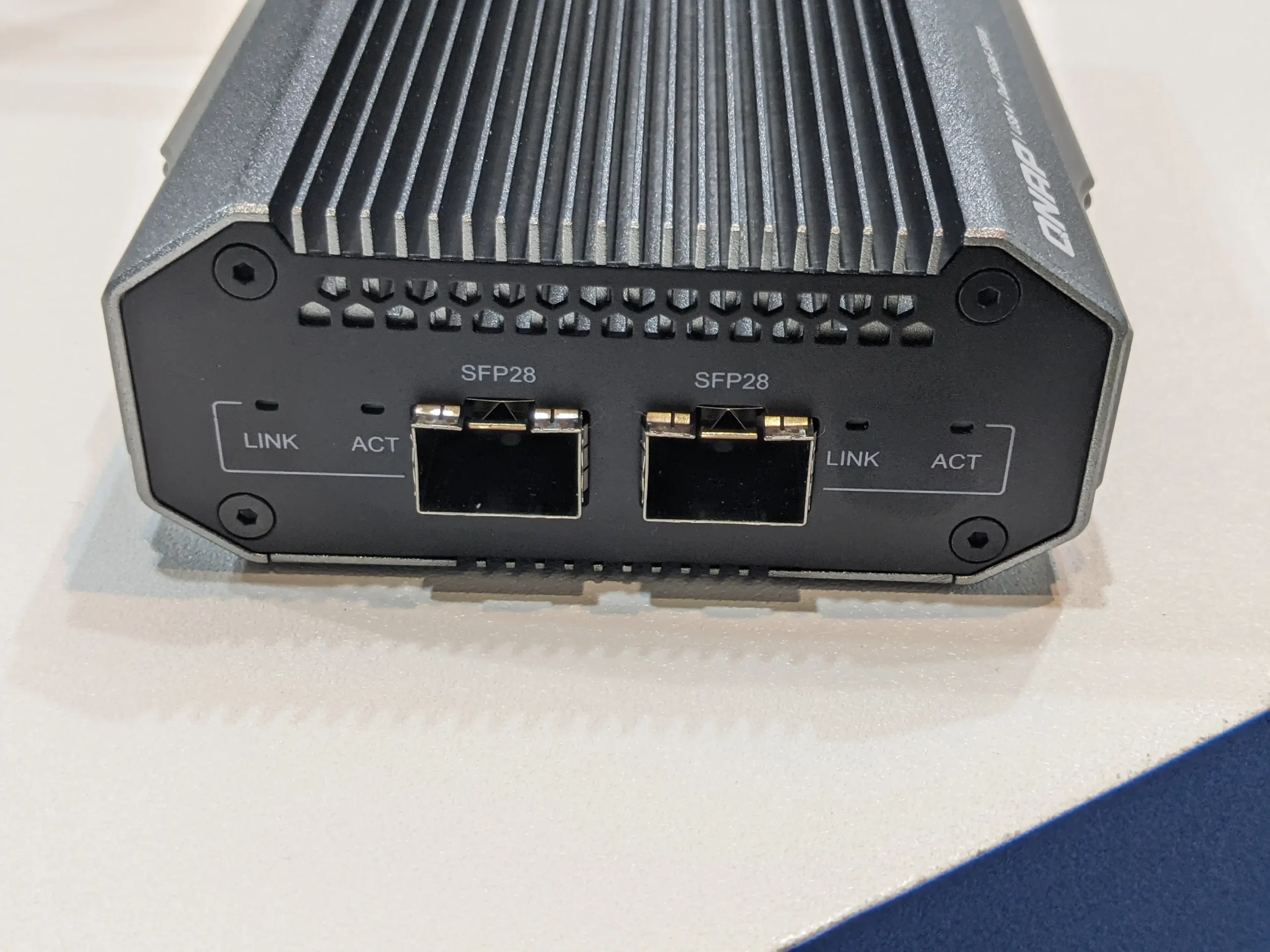
QNA-UC25G2SF – USB4 to Dual-Port 25GbE SFP28 Adapter
This higher-bandwidth model offers dual 25GbE SFP28 ports via a single USB4 connection. Due to increased power requirements, it includes a second USB-C port for PD (Power Delivery). Two 25GbE transceivers are included. This device targets studios and enterprise setups needing ultra-fast file transfer or VM-to-host access from portable systems.
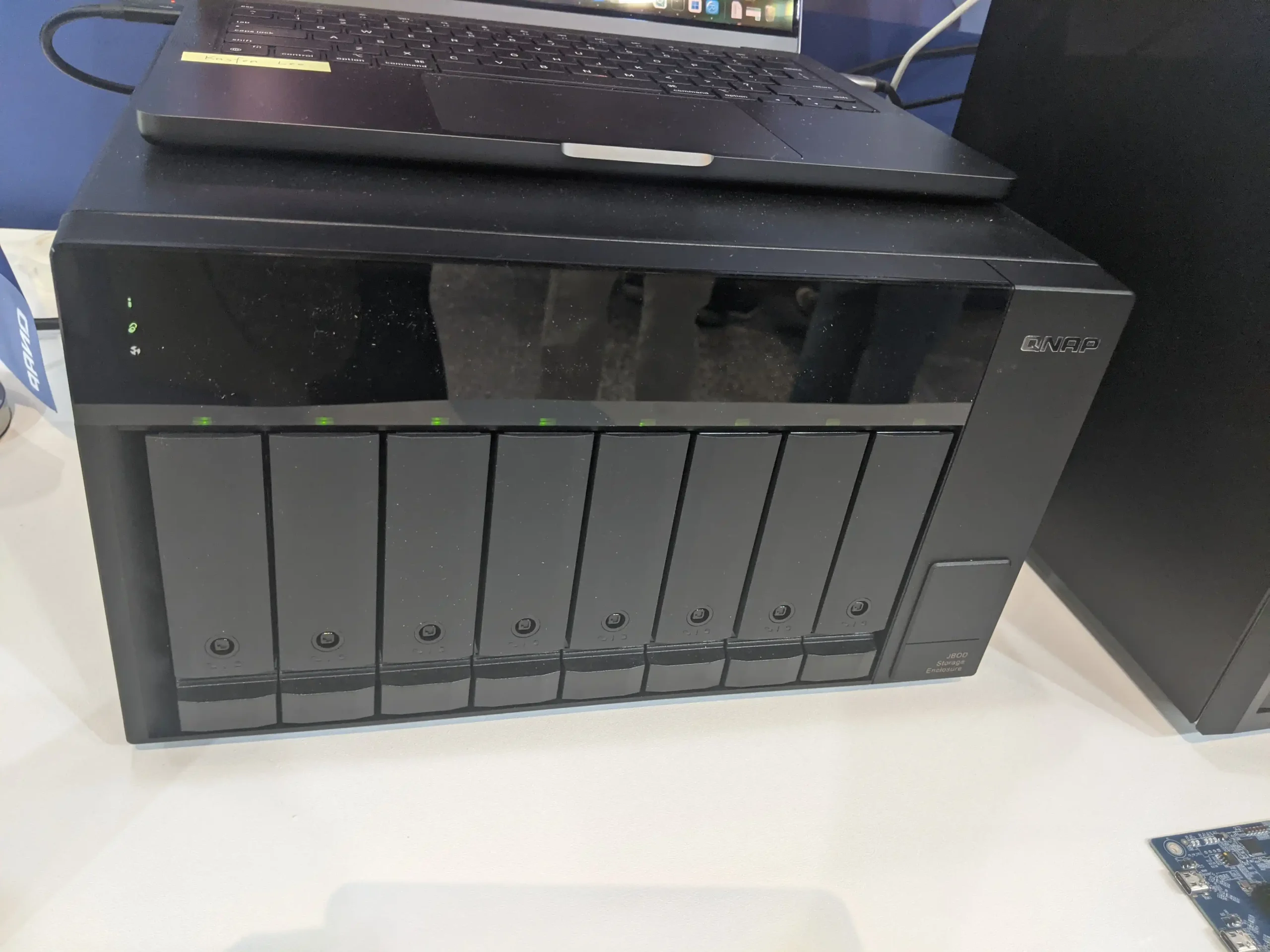
TL-D810TC4 – 8-Bay USB4 JBOD Enclosure
This hot-swappable SATA enclosure provides 8 x 3.5-inch drive bays over a single USB4 40Gbps connection, supporting high-capacity HDDs or SSDs. Designed as an expansion solution for Thunderbolt/USB4-compatible NAS or PCs, it includes smart/manual fan control, and is positioned as a scalable media storage device for video editors, content creators, and backup environments.
All these devices are plug-and-play and designed for cross-platform use (Mac/Windows/Linux where supported), and help bridge the performance gap between traditional NAS systems and direct-attached workflows in hybrid production setups.
USB4 Expansion Solutions – Overview
| Model | Description | Ports | Notable Features |
|---|---|---|---|
| QNA-UC10G2SF | USB4 to 2 x 10GbE SFP+ Adapter | 2 x SFP+ | Fanless, includes 2 transceivers, low power |
| QNA-UC25G2SF | USB4 to 2 x 25GbE SFP28 Adapter | 2 x SFP28 | PD support, includes 2 transceivers |
| TL-D810TC4 | 8-Bay USB4 JBOD Expansion Enclosure | 8 x SATA bays | 40Gbps USB4, smart/manual cooling, hot-swap |
TS-h1077AFU – 1U All-Flash Rackmount NAS with Ryzen 7 and PCIe Gen 4
The QNAP TS-h1077AFU is a 1U rackmount NAS designed for high-performance, latency-sensitive workloads requiring SSD-only configurations. It is equipped with an AMD Ryzen 7 Pro 7745/7700 processor, offering up to 8 cores and a maximum boost clock of 5.3GHz. This CPU choice allows for substantial multi-threaded throughput, making the unit suitable for containerized environments, virtualization, and enterprise-grade data services. The system features 10 x 2.5-inch SATA SSD bays, optimized for full flash arrays (AFA), which support consistently high IOPS and bandwidth for applications like VDI, database hosting, or video post-production. For expansion, it includes 2 x PCIe Gen 4 x8 slots, enabling the addition of 25GbE NICs, SAS expansion cards, or even GPU accelerators depending on thermal and power constraints.
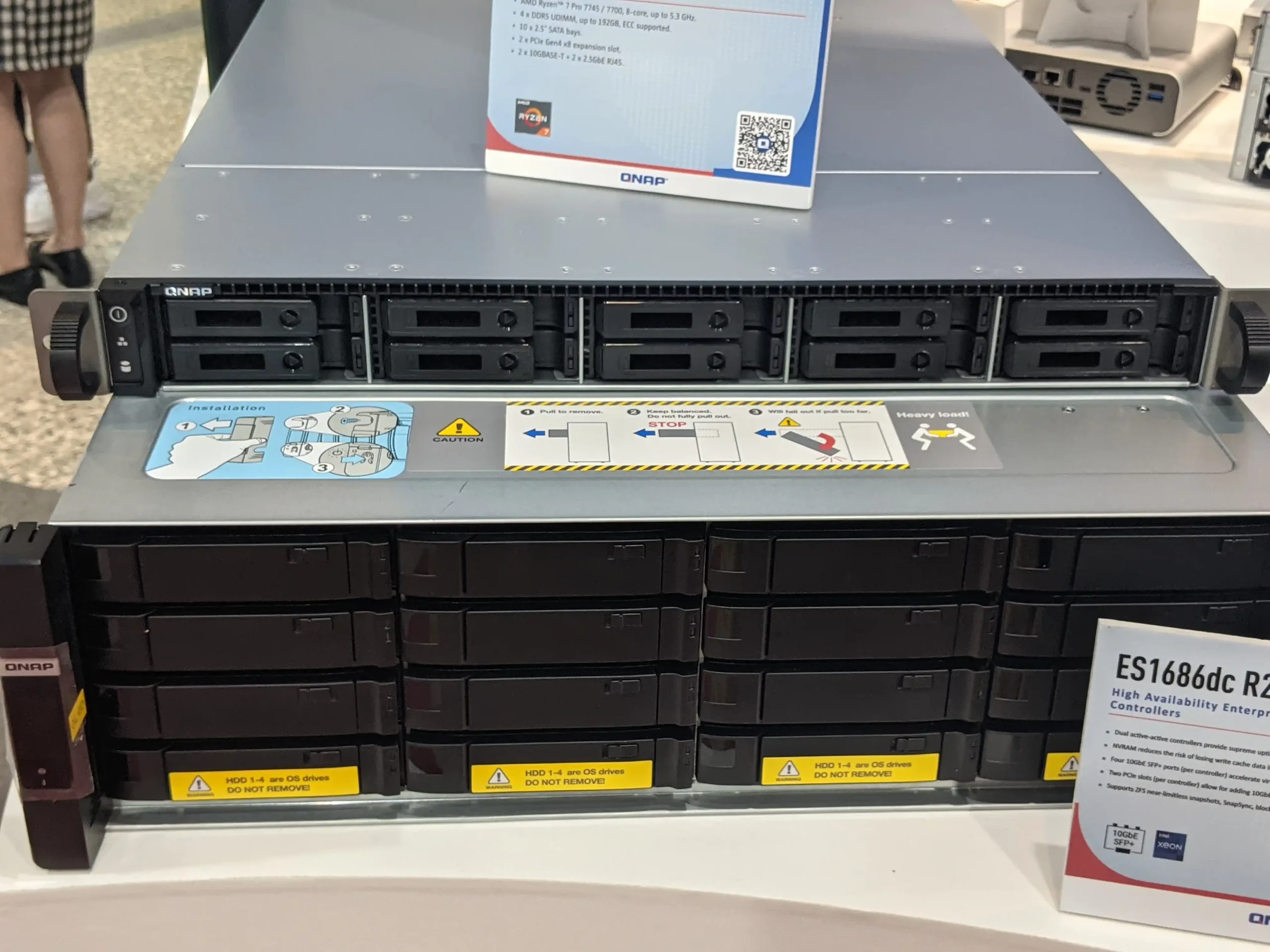
Networking is built-in with 2 x 10GBASE-T and 2 x 2.5GbE RJ45 ports, providing flexible connectivity options for core and edge deployments. With DDR5 ECC memory support, the TS-h1077AFU can be expanded up to 192GB, ensuring system reliability in mission-critical operations. This system runs on QuTS hero, leveraging the ZFS file system with support for deduplication, compression, inline snapshots, and real-time synchronization. It integrates easily into hybrid storage environments through FileTiers, Hybrid Backup Center, and QuTScloud support.
| Feature | Details |
|---|---|
| CPU | AMD Ryzen 7 Pro 7745/7700 (8-core, up to 5.3GHz) |
| Memory | DDR5 ECC UDIMM, up to 192GB |
| Drive Bays | 10 x 2.5″ SATA SSD (hot-swappable) |
| Network Ports | 2 x 10GBASE-T + 2 x 2.5GbE RJ45 |
| PCIe Expansion | 2 x PCIe Gen 4 x8 |
| Form Factor | 1U Rackmount |
| File System | ZFS (QuTS hero) |
| Key Features | All-flash performance, ECC memory, Gen 4 expansion, HA-ready |
| Use Cases | Virtualization, databases, VDI, SSD-based backup targets |
TS-262A and TS-462A – Entry-Level Intel NAS for Home and Small Office Users
The TS-262A and TS-462A are updated tower NAS models designed to serve the needs of entry-level users, home offices, and small businesses. Both systems are built around the Intel Celeron N5095, a quad-core processor running at 2.0GHz (burst up to 2.9GHz), providing modest compute resources for basic file sharing, backups, multimedia streaming, and light virtualization.
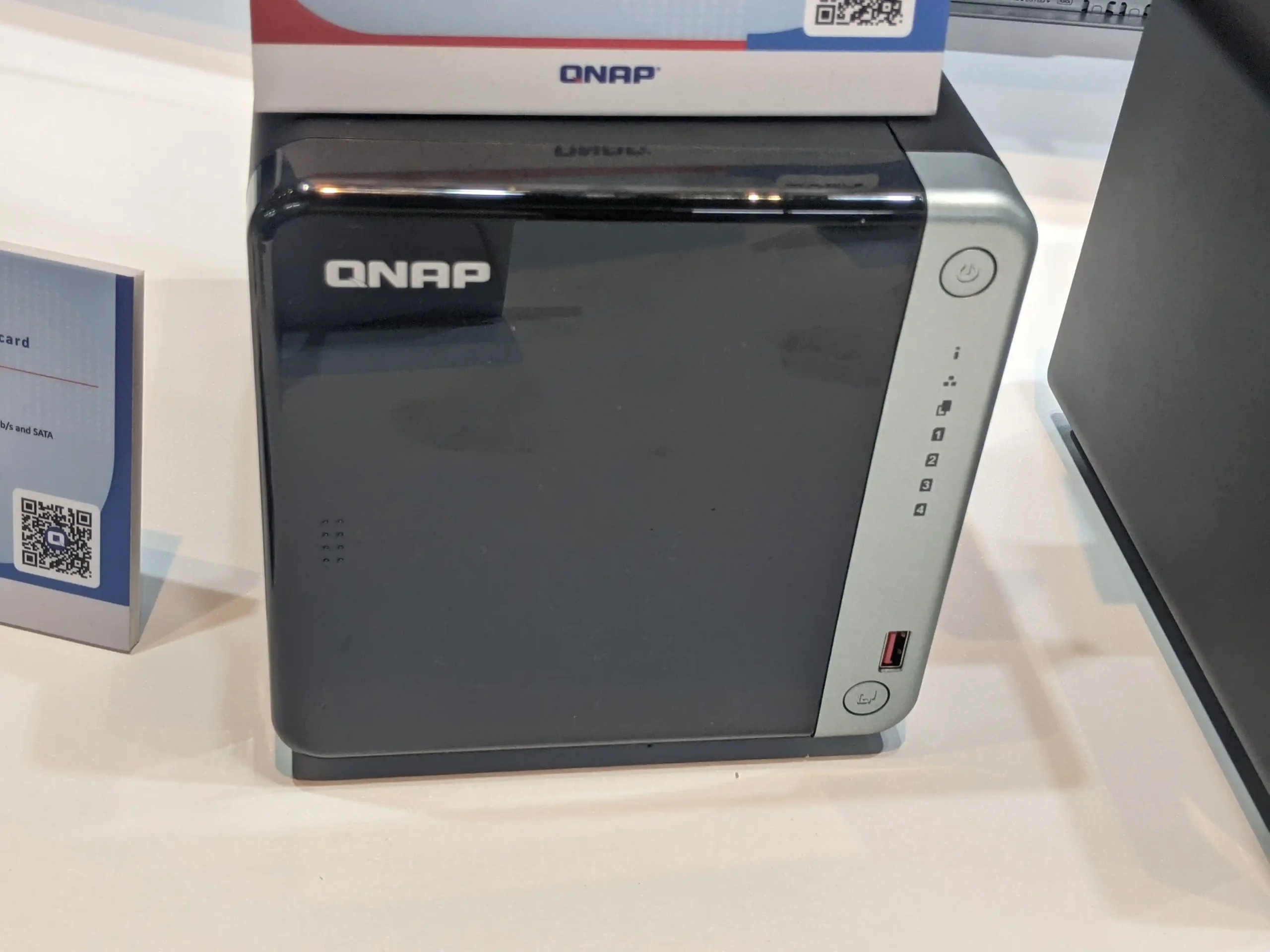
The TS-262A features 2 x 3.5-inch SATA bays, while the TS-462A expands this to 4 x 3.5-inch SATA bays, offering greater capacity for RAID configurations and future scalability. Both models support 2 x M.2 2280 PCIe Gen 3 x1 NVMe SSDs, allowing users to create SSD cache or performance volumes for improved access speeds on frequently used files.
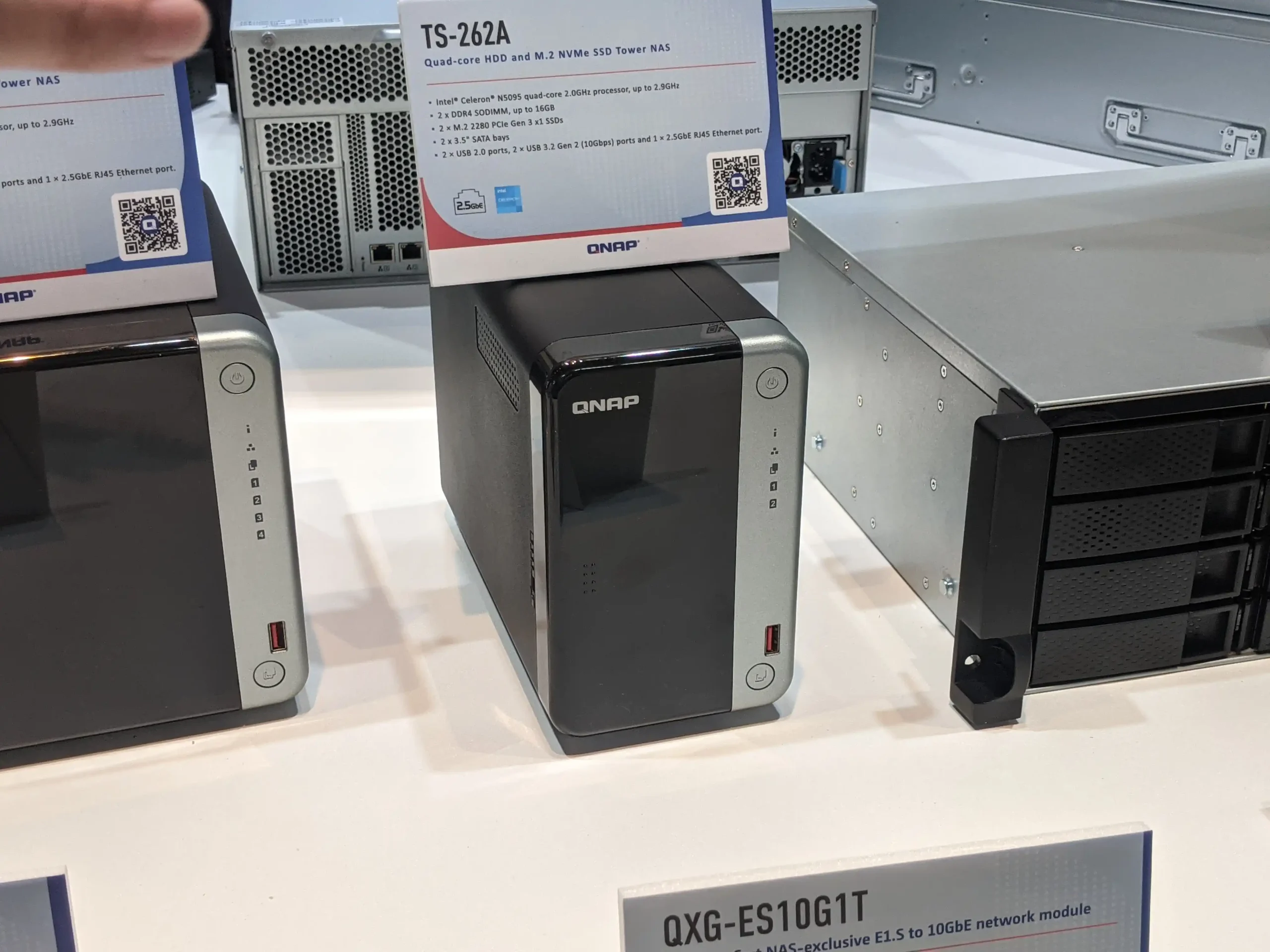
Each system includes 2 x USB 2.0 ports, 2 x USB 3.2 Gen 2 ports (10Gbps), and 1 x 2.5GbE RJ45 port, offering a notable upgrade from traditional 1GbE-only units. However, unlike the 64-series QNAP NAS models, neither of these units includes a PCIe expansion slot, meaning network or port upgrades are not supported beyond what is pre-installed.
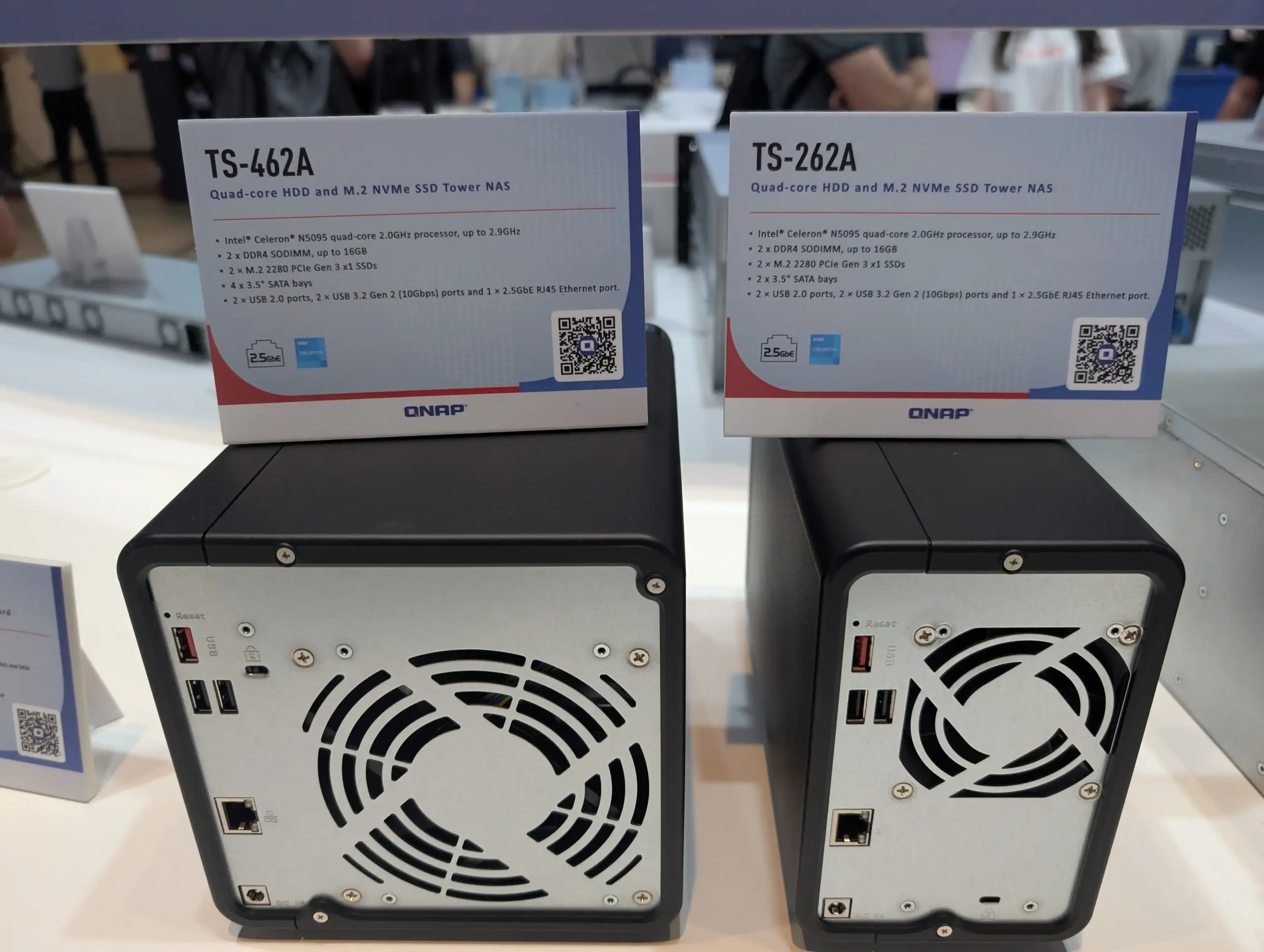
These units run QTS, offering features like Snapshot Backup, Hybrid Backup Sync (HBS3), multimedia streaming applications, and Container Station for lightweight container use. Both systems are capable of running Plex Media Server and basic Docker workloads, although limitations in CPU/GPU mean users should not expect real-time 4K transcoding.
| Feature | TS-262A | TS-462A |
|---|---|---|
| CPU | Intel Celeron N5095 (4C/4T, up to 2.9GHz) | Intel Celeron N5095 (4C/4T, up to 2.9GHz) |
| Memory | 2 x DDR4 SODIMM (up to 16GB) | 2 x DDR4 SODIMM (up to 16GB) |
| Drive Bays | 2 x 3.5″ SATA HDD | 4 x 3.5″ SATA HDD |
| M.2 Slots | 2 x M.2 2280 PCIe Gen 3 x1 | 2 x M.2 2280 PCIe Gen 3 x1 |
| Network | 1 x 2.5GbE RJ45 | 1 x 2.5GbE RJ45 |
| USB Ports | 2 x USB 2.0, 2 x USB 3.2 Gen 2 | 2 x USB 2.0, 2 x USB 3.2 Gen 2 |
| PCIe Slot | Not included | Not included |
| Software | QTS | QTS |
| Use Cases | Backup, file server, media playback, Plex (basic) | Backup, file server, media playback, Plex (basic) |
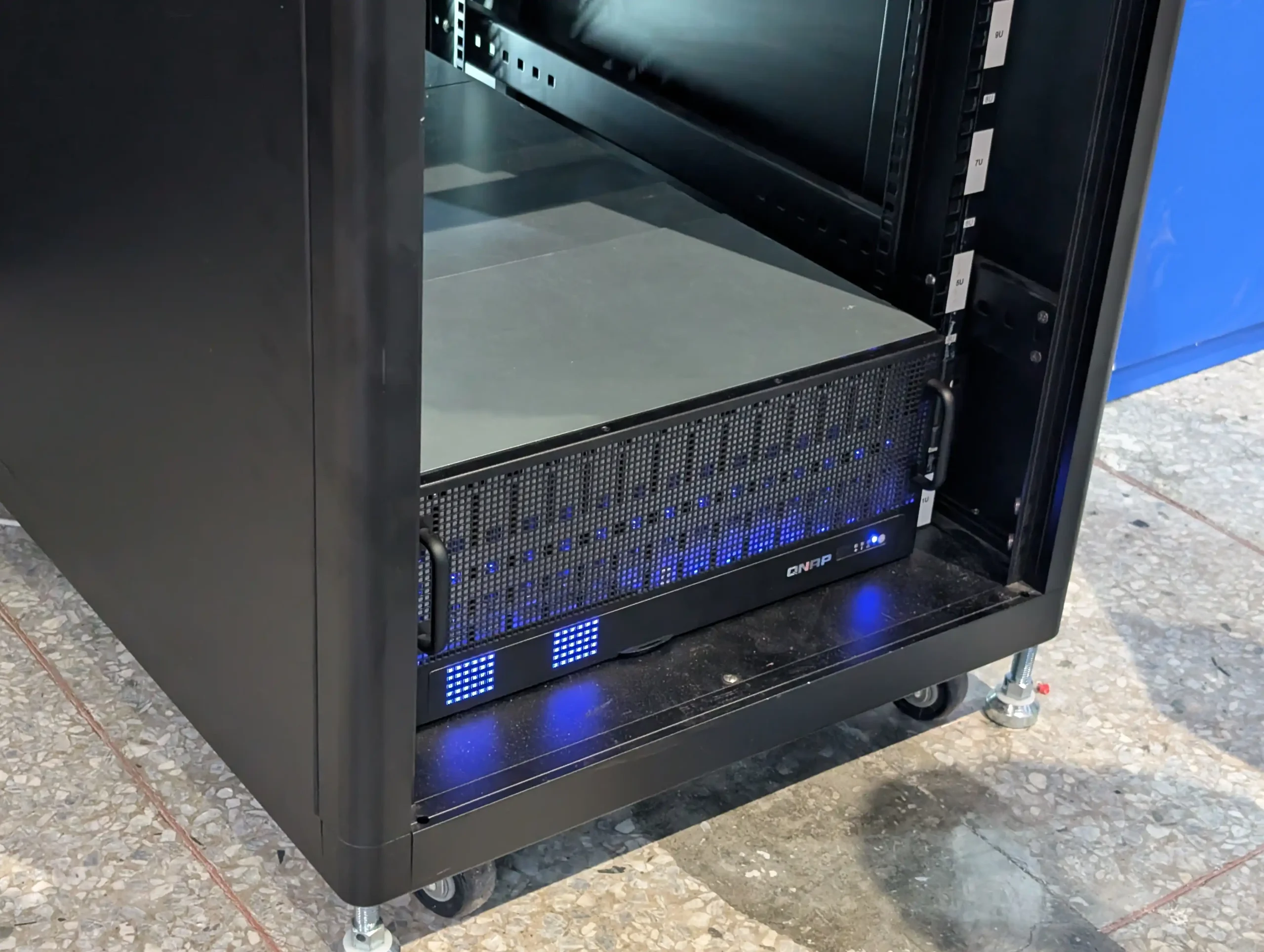
QuTS Mega and 60 Bay Scale Out Enclsoure – Scale-Out NAS and Petabyte-Level Expansion
At Computex 2025, QNAP showcased QuTS Mega, its scale-out NAS operating system designed for high-capacity, high-performance deployments. Unlike traditional NAS setups, QuTS Mega enables multiple NAS nodes to operate in a single clustered environment, supporting linear scaling of both capacity and performance. This architecture is ideal for organizations dealing with large datasets over long retention periods—such as media archives, surveillance storage, or AI training sets.
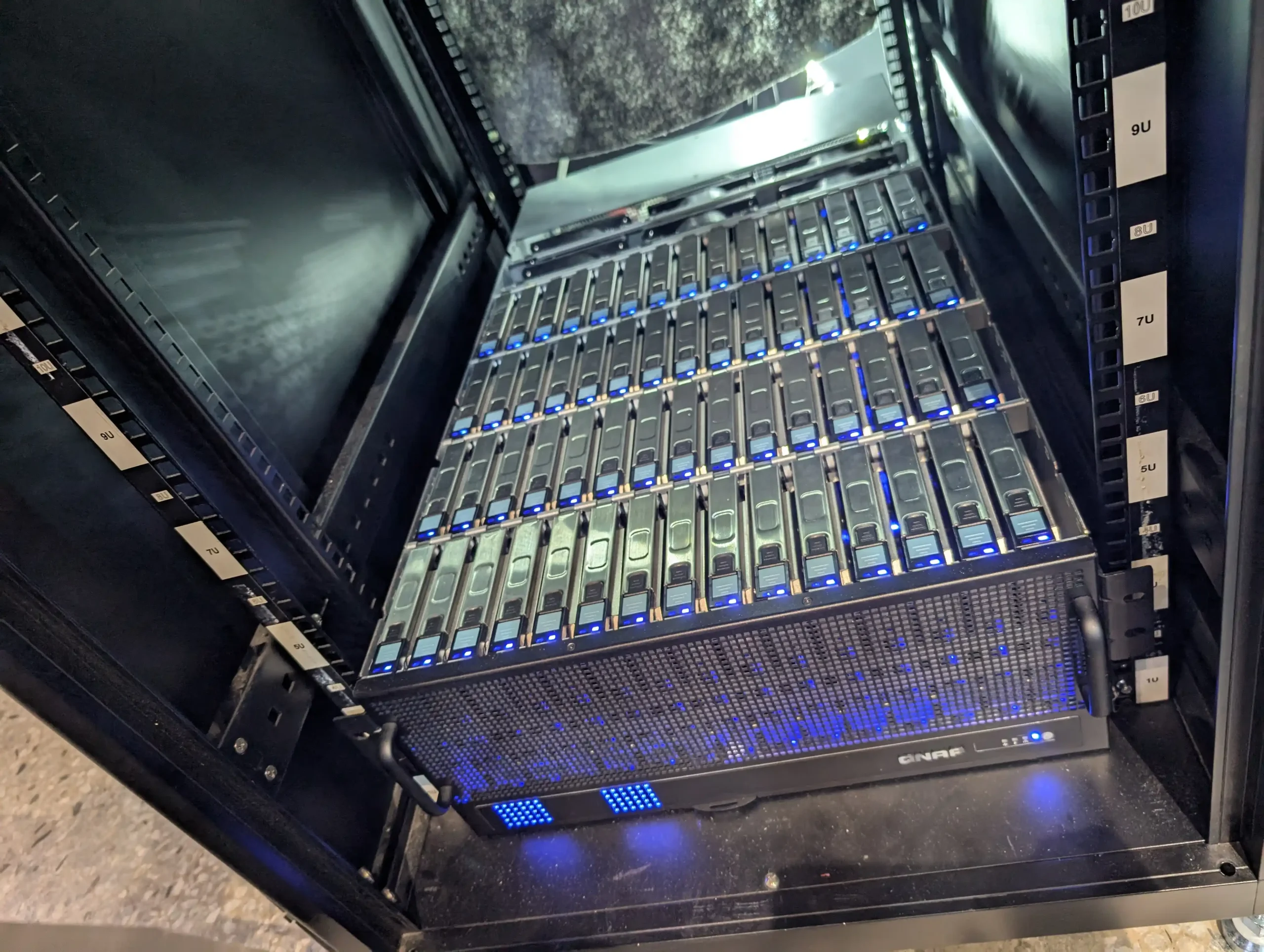
To demonstrate this, QNAP introduced the a 60-bay JBOD enclosure compatible with SAS or SATA drives. Each unit connects via HD Mini-SAS and can be configured using dual-port or quad-port SAS expansion cards, offering 12Gbps throughput per link. In QuTS Mega environments, these enclosures are used to form part of a multi-node cluster—QNAP stated support for up to 96 nodes, scaling total usable capacity up to 45 petabytes with redundancy features like triple parity RAID options.
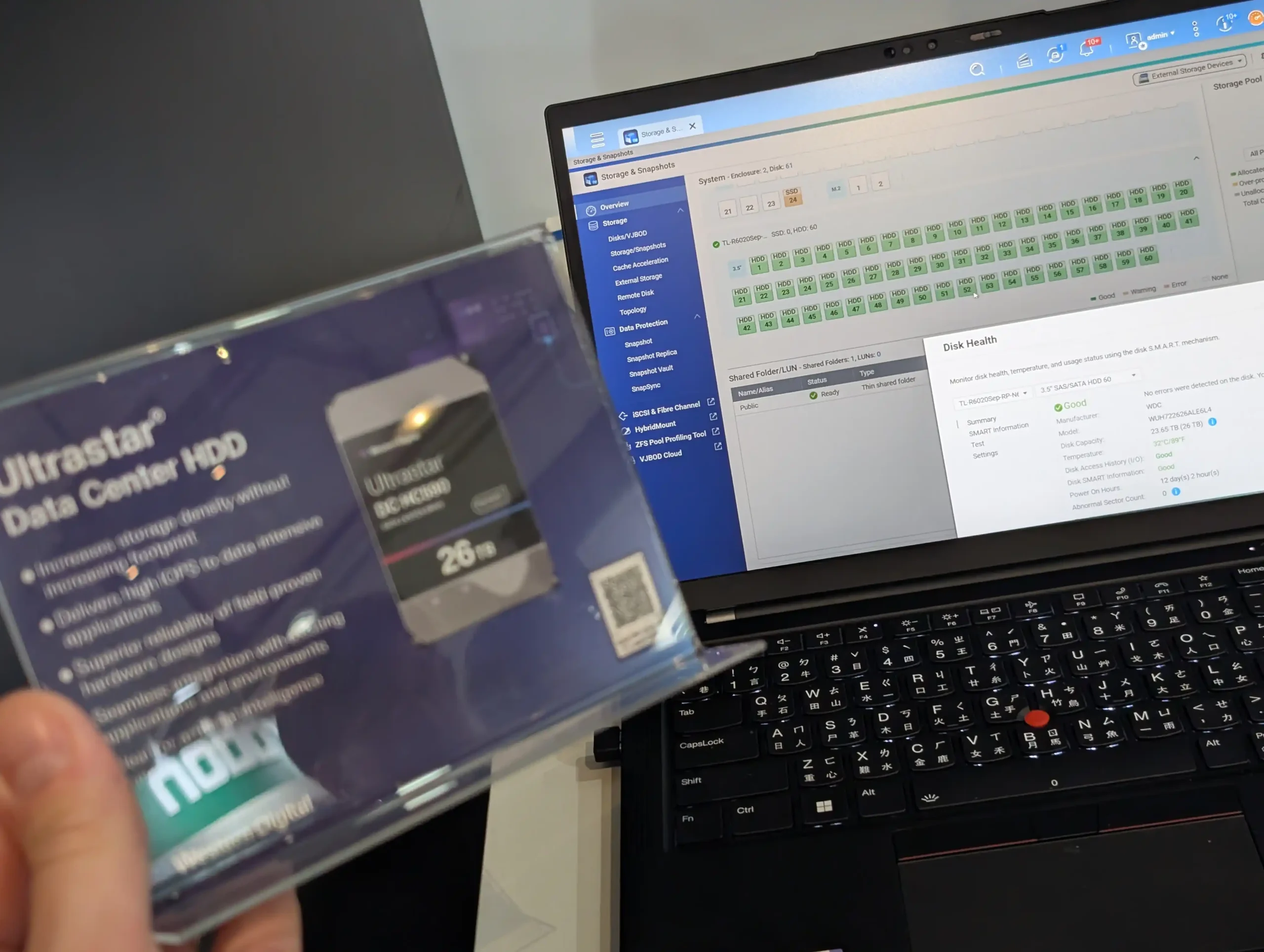
QuTS Mega is distinct from QTS and QuTS hero in that it is purpose-built for clustered data storage. It supports intelligent data distribution across nodes, node redundancy, and non-disruptive expansion. This eliminates the need for forklift upgrades or data migrations when scaling infrastructure. All nodes in a QuTS Mega cluster operate under a single namespace, simplifying storage management for administrators.
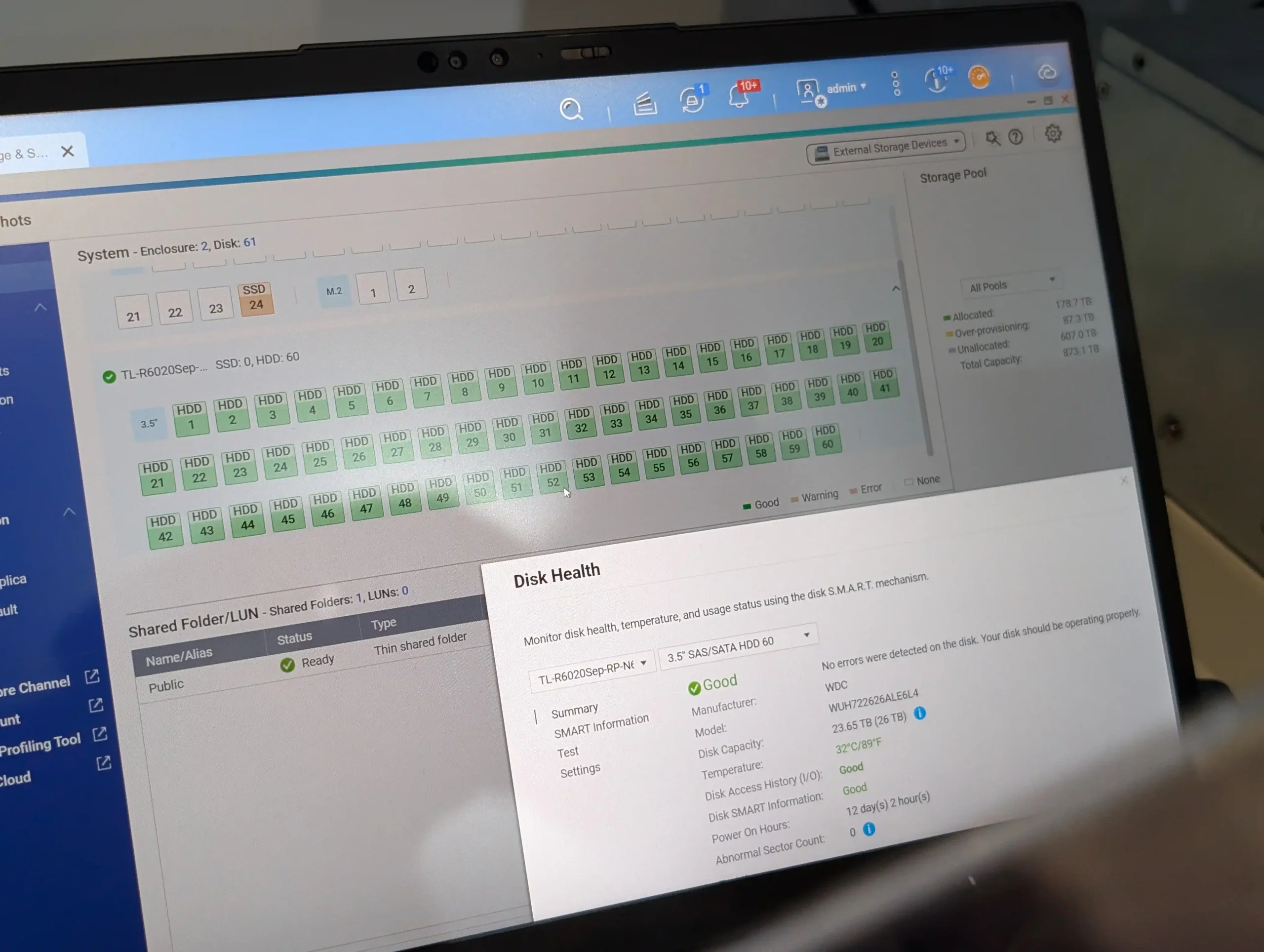
QNAP’s live demo at the Tech Summit included MC-LAG (Multi-Chassis Link Aggregation) between switches, showing seamless failover and uninterrupted iSCSI/SMB connectivity even during network outages—further reinforcing QuTS Mega’s design for high-availability storage backbones.
| Feature | Details |
|---|---|
| OS Platform | QuTS Mega (scale-out NAS OS) |
| Cluster Size | Up to 96 nodes |
| Total Capacity | Up to 45PB (with 60-bay JBODs) |
| JBOD Drive Bays | 60 x 3.5″ SAS/SATA |
| Expansion Cards | 2-port and 4-port 12Gb SAS cards available |
| RAID Support | Includes triple-parity configurations |
| Networking | Supports MC-LAG and seamless failover between clustered nodes |
| Use Cases | Petabyte-scale backup, media archiving, AI training, tiered cloud sync |
TS-h1655XeU-RP – Short-Depth 3U Rackmount NAS with Hybrid SSD Support
The QNAP TS-h1655XeU-RP is a 3U short-depth rackmount NAS designed for environments requiring high-density storage in shallow enclosures, such as edge data centers or space-constrained AV deployments. It combines large-capacity HDD storage with high-speed SSD caching capabilities, making it suitable for virtualized infrastructure, surveillance archiving, or tiered storage environments. The system is powered by an Intel Atom C5125, an 8-core processor operating at 2.8GHz, which balances efficiency with adequate performance for file services, surveillance management, and backup workloads. It supports ECC RAM and offers two DDR4 SODIMM slots, with expansion support for up to 64GB depending on configuration.
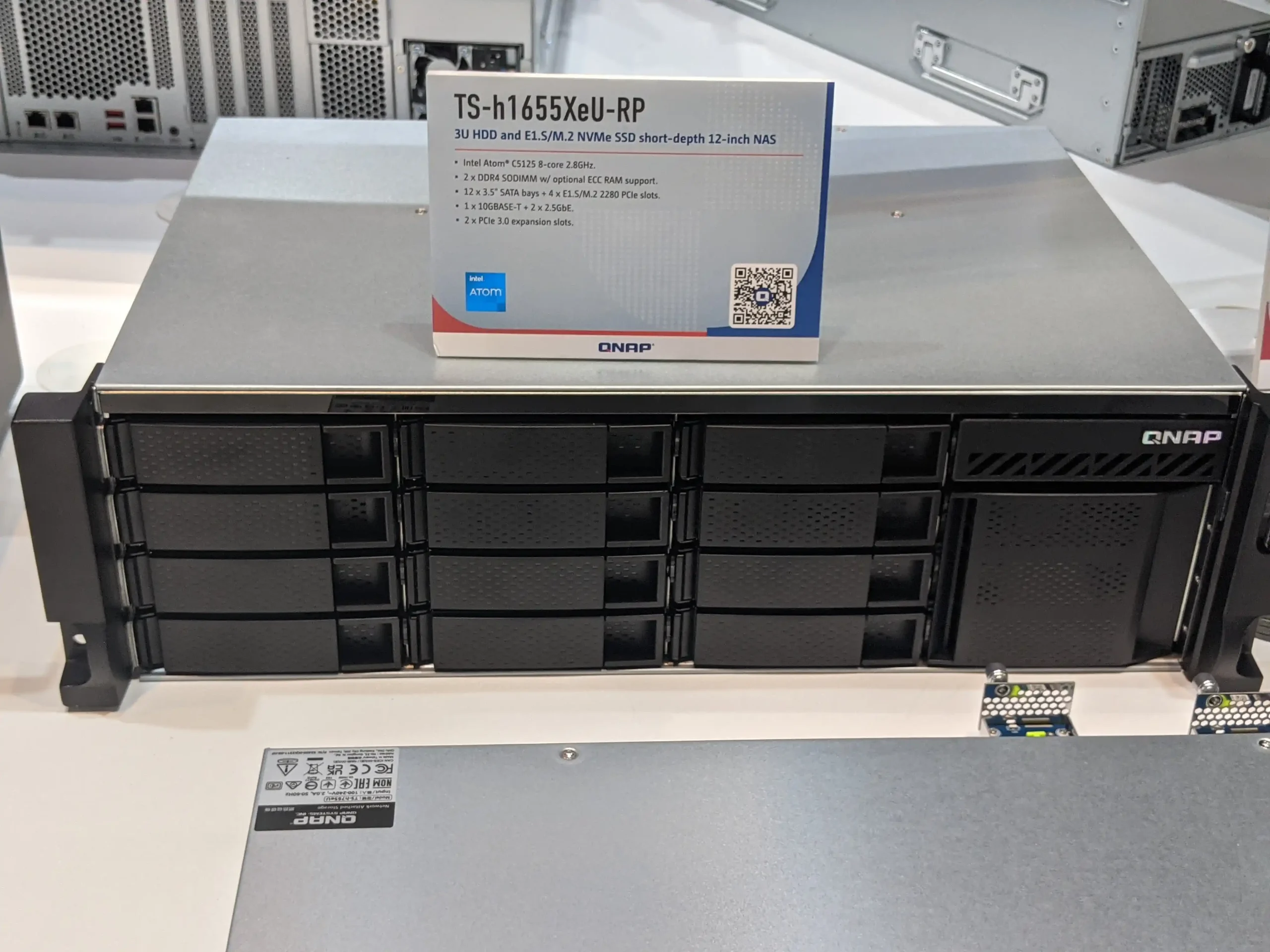
The chassis includes 12 x 3.5-inch SATA drive bays, supporting high-capacity HDDs, and 4 x E1.S or M.2 2280 PCIe SSD slots, ideal for deploying SSD caches or high-IOPS VM storage volumes. This hybrid layout enables intelligent data placement and supports FileTiers for tiered storage strategies.
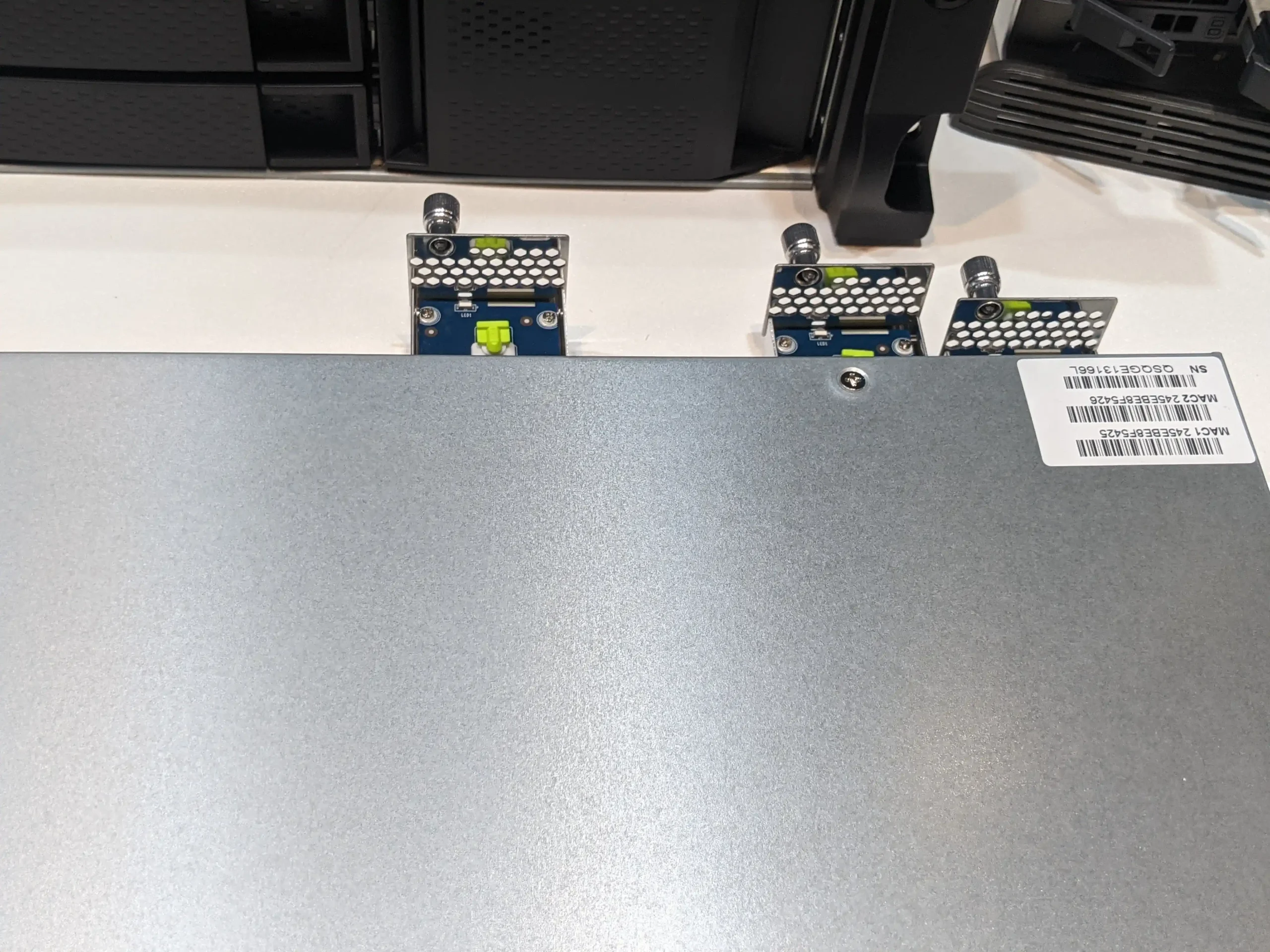
Networking consists of 1 x 10GBASE-T and 2 x 2.5GbE RJ45 ports, with optional PCIe 3.0 expansion via 2 available slots for additional NICs or storage interface cards. This unit runs QuTS hero, leveraging ZFS features such as inline deduplication, compression, SnapSync, and nearly unlimited snapshots. With its short-depth 12-inch chassis and redundant PSU (RP) support, the TS-h1655XeU-RP is targeted at deployments where rack depth, service uptime, and flexible media configurations are primary considerations.
| Feature | Details |
|---|---|
| CPU | Intel Atom C5125 (8-core, 2.8GHz) |
| Memory | DDR4 SODIMM (ECC optional), up to 64GB |
| Drive Bays | 12 x 3.5″ SATA HDD + 4 x E1.S / M.2 2280 PCIe SSD |
| Network Ports | 1 x 10GBASE-T + 2 x 2.5GbE RJ45 |
| PCIe Expansion | 2 x PCIe 3.0 slots |
| Chassis Depth | 12-inch short-depth (3U height) |
| Power Supply | Redundant (RP) |
| File System | ZFS (QuTS hero) |
| Use Cases | Edge deployment, tiered storage, surveillance, branch office servers |
Hybrid Backup Center and myQNAPcloud One – Unified Backup, Immutability, and Multi-Site Control
QNAP used the Tech Summit 2025 to unveil an upgraded version of its data protection ecosystem, anchored by the new Hybrid Backup Center and the expanding capabilities of myQNAPcloud One. Together, these tools aim to provide a unified, policy-driven backup infrastructure for NAS-to-NAS, NAS-to-cloud, and multi-site environments.
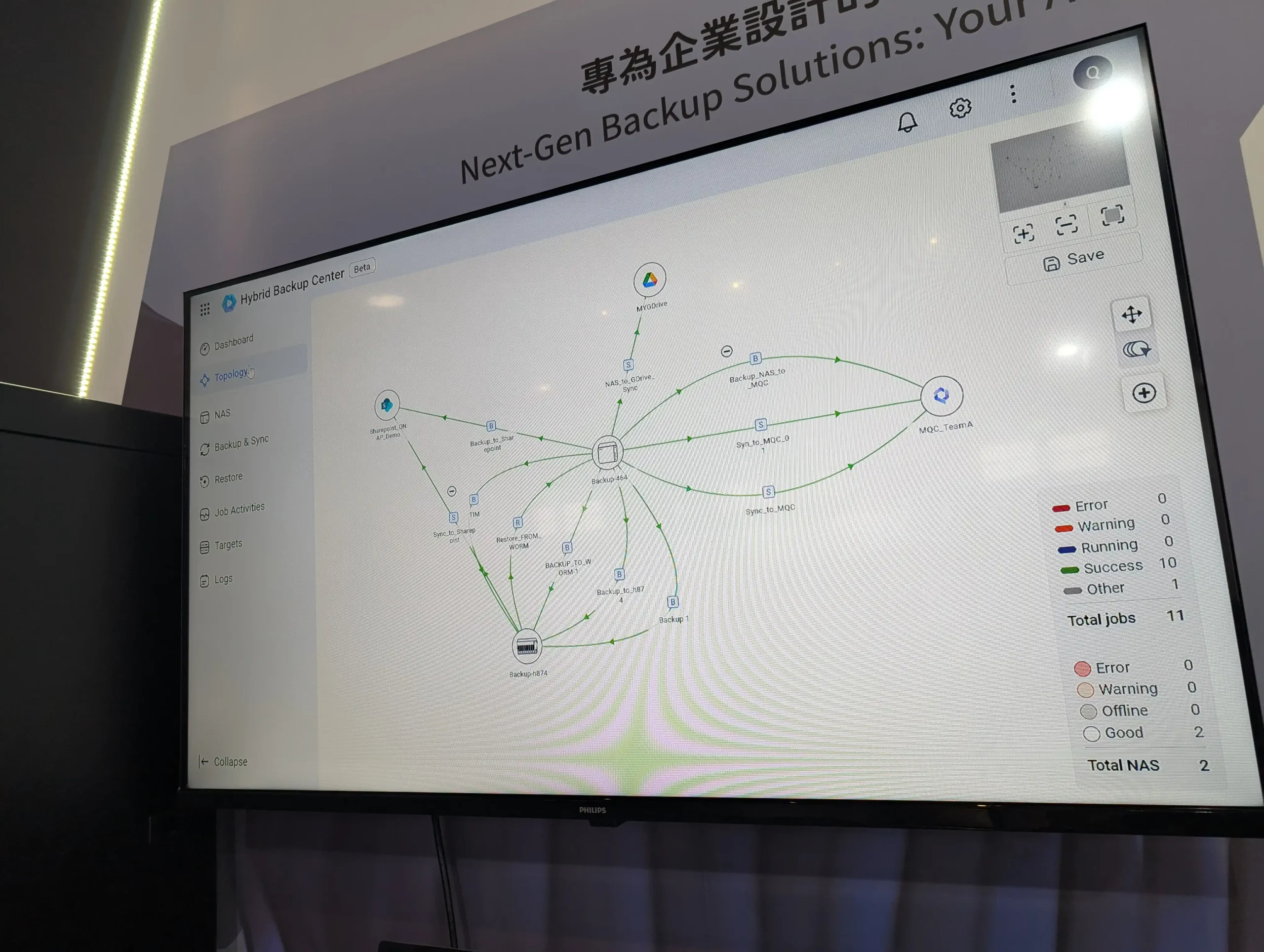
The Hybrid Backup Center builds upon the earlier HBS3 platform, providing a centralized dashboard for managing backup tasks across all connected devices. It includes a real-time topology view, allowing administrators to visualize active jobs, destination targets, and data flow between NAS units and cloud services. The system supports local snapshots, remote replication, and cloud synchronization, all of which can be monitored and managed from a single interface.
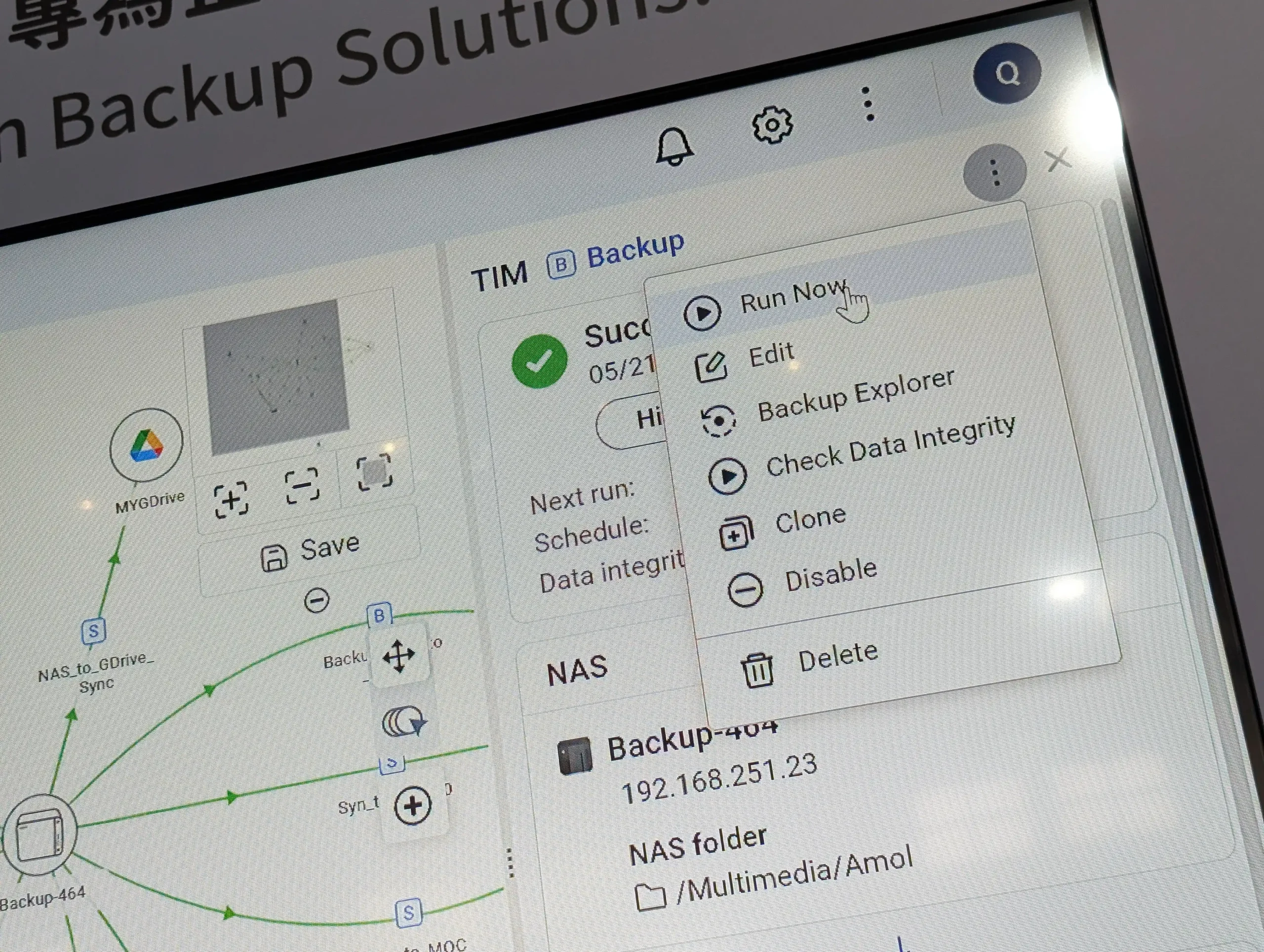
One of the most significant upgrades is support for immutable backups, which can be enforced on both local NAS volumes and cloud targets. This ensures that backup data cannot be modified or deleted for a user-defined retention period, protecting against ransomware, accidental deletion, or tampering. Integration with QuLog Center also enables alerting and auditing, helping IT administrators track backup success/failure and user interaction with backup sets.
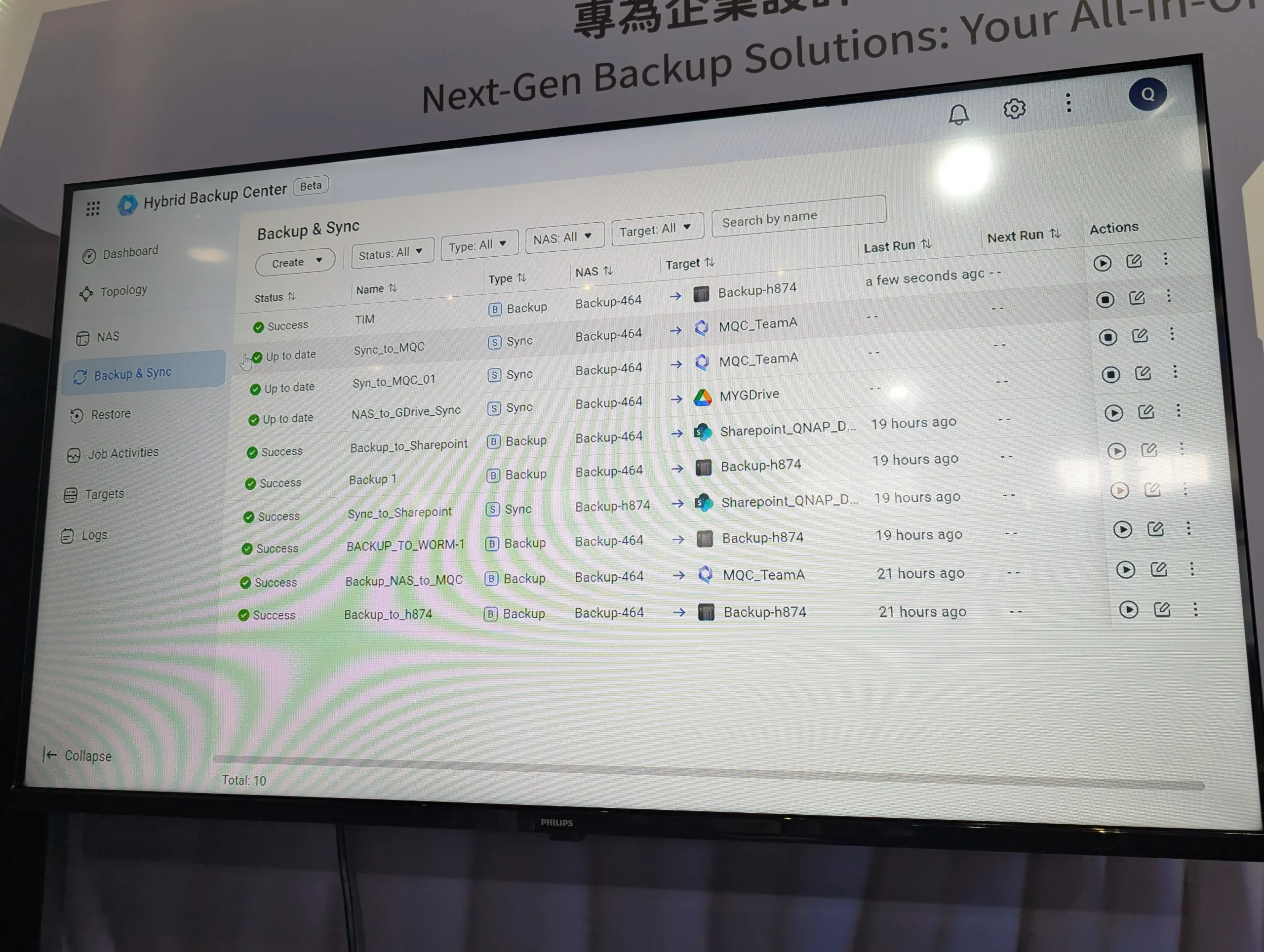
myQNAPcloud One, originally introduced in earlier product cycles, now operates as a full-featured object and file storage platform. It’s available under a subscription model with transparent pricing tiers that avoid bandwidth or API call surcharges. Designed for enterprise users, it supports tiered archiving from FileTiers, cloud snapshots, and off-site replication of backup tasks. When paired with QTS or QuTS hero NAS systems, it enables hybrid backup strategies with automatic data tiering between local SSD, HDD, and cloud storage.
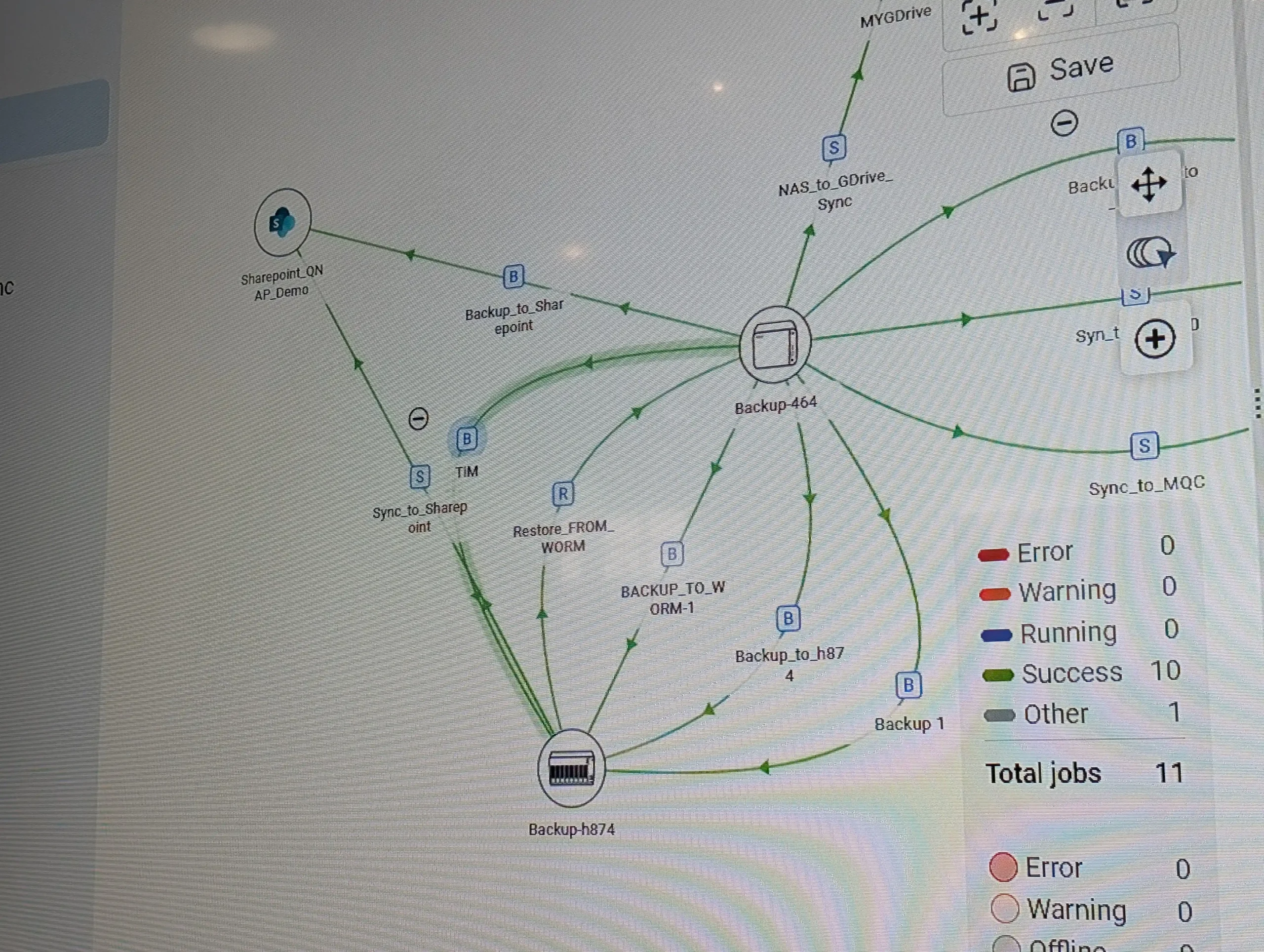
These platforms are also tightly integrated with AMIZcloud, QNAP’s centralized fleet and lifecycle management portal, which provides global monitoring, health checks, and backup verification reports across large deployments.
| Feature | Details |
|---|---|
| Hybrid Backup Center | Central dashboard for managing multi-site NAS backups |
| Backup Types | Local snapshot, remote replication, NAS-to-cloud sync |
| Immutability Support | Enforced on local volumes and cloud backups |
| Topology View | Real-time mapping of jobs and targets |
| Cloud Platform | myQNAPcloud One (subscription-based, no API/bandwidth penalties) |
| Use Cases | Ransomware protection, long-term archiving, distributed site backups |
| Integration | FileTiers, QuLog Center, AMIZcloud, Qsirch AI indexing support |
QBoat Industrial NAS – Fanless M.2-Based System for Harsh Environments
The QNAP QET Industrial NAS is a rugged, compact network-attached storage solution designed specifically for deployment in industrial and factory environments, where environmental conditions may exceed the tolerance of traditional IT hardware. Engineered for wide temperature operation, the unit is rated for -40°C to +70°C, making it suitable for remote monitoring stations, production lines, and embedded data logging systems.
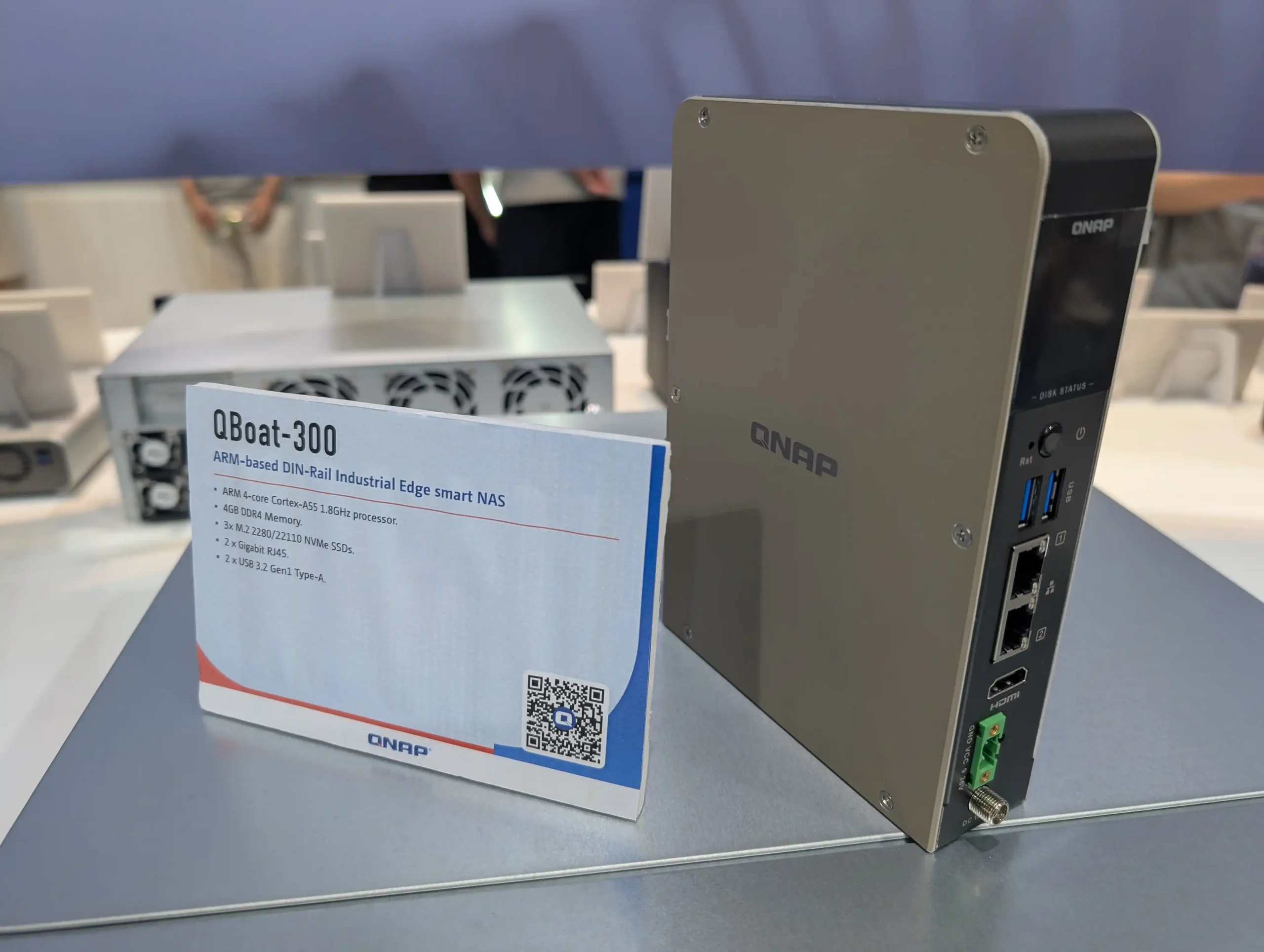
The system is built in a fanless chassis with enhanced thermal design, allowing passive cooling even under load. Internally, it supports 3 x M.2 NVMe SSDs, delivering full solid-state storage performance without the moving parts or vibration concerns associated with HDDs. These M.2 drives are ideal for applications requiring high-speed writes and reliability, such as sensor data capture or control system logging.
Connectivity is handled via 2 x Gigabit Ethernet ports, which are sufficient for industrial deployment scenarios where redundancy or dual-network operations are required. The device is powered via a robust industrial-grade power input, supporting wider voltage ranges and enhanced electrical protection.
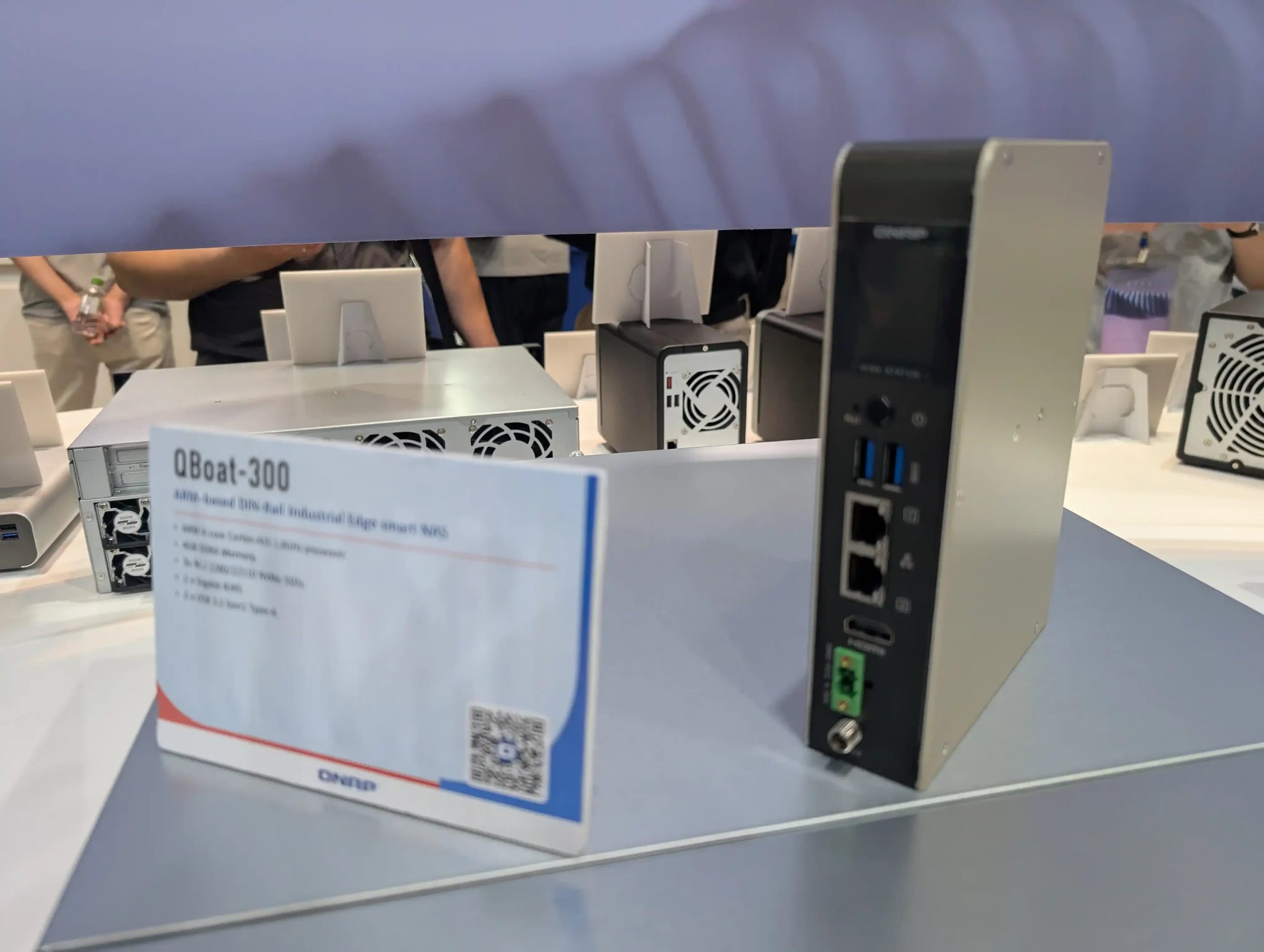
The QET Industrial NAS is managed using QTS or QuTS hero, depending on the specific configuration, and supports standard QNAP services such as Hybrid Backup, QVR surveillance integration, and remote management via AMIZcloud. It provides a low-maintenance solution with on-prem AI inference support, allowing local deployment of lightweight AI models using hardware such as Google Coral TPUs or M.2 AI accelerators.
QET Industrial NAS – Specifications
| Feature | Details |
|---|---|
| CPU | Not explicitly detailed (low-power embedded class) |
| Memory | Not specified (likely soldered or small SO-DIMM) |
| Storage | 3 x M.2 NVMe SSDs |
| Network Ports | 2 x Gigabit Ethernet |
| Power Input | Industrial-grade (wide voltage range, ruggedized) |
| Cooling | Fanless passive cooling |
| Operating Temp Range | -40°C to +70°C |
| Software | QTS or QuTS hero |
| Use Cases | MES systems, remote industrial sites, embedded AI, harsh environments |
QAI-H1290FX – Edge AI NAS with RTX GPU Acceleration and On-Prem RAG Search
The QNAP QAI-H1290FX is a purpose-built edge AI storage server designed to enable on-premises deployment of large language models (LLMs) and retrieval-augmented generation (RAG) workflows without relying on cloud infrastructure. Positioned as an appliance for enterprises seeking data privacy, lower latency, and full control over their AI infrastructure, the QAI-H1290FX includes pre-installed GPU hardware and integrated AI software capabilities.
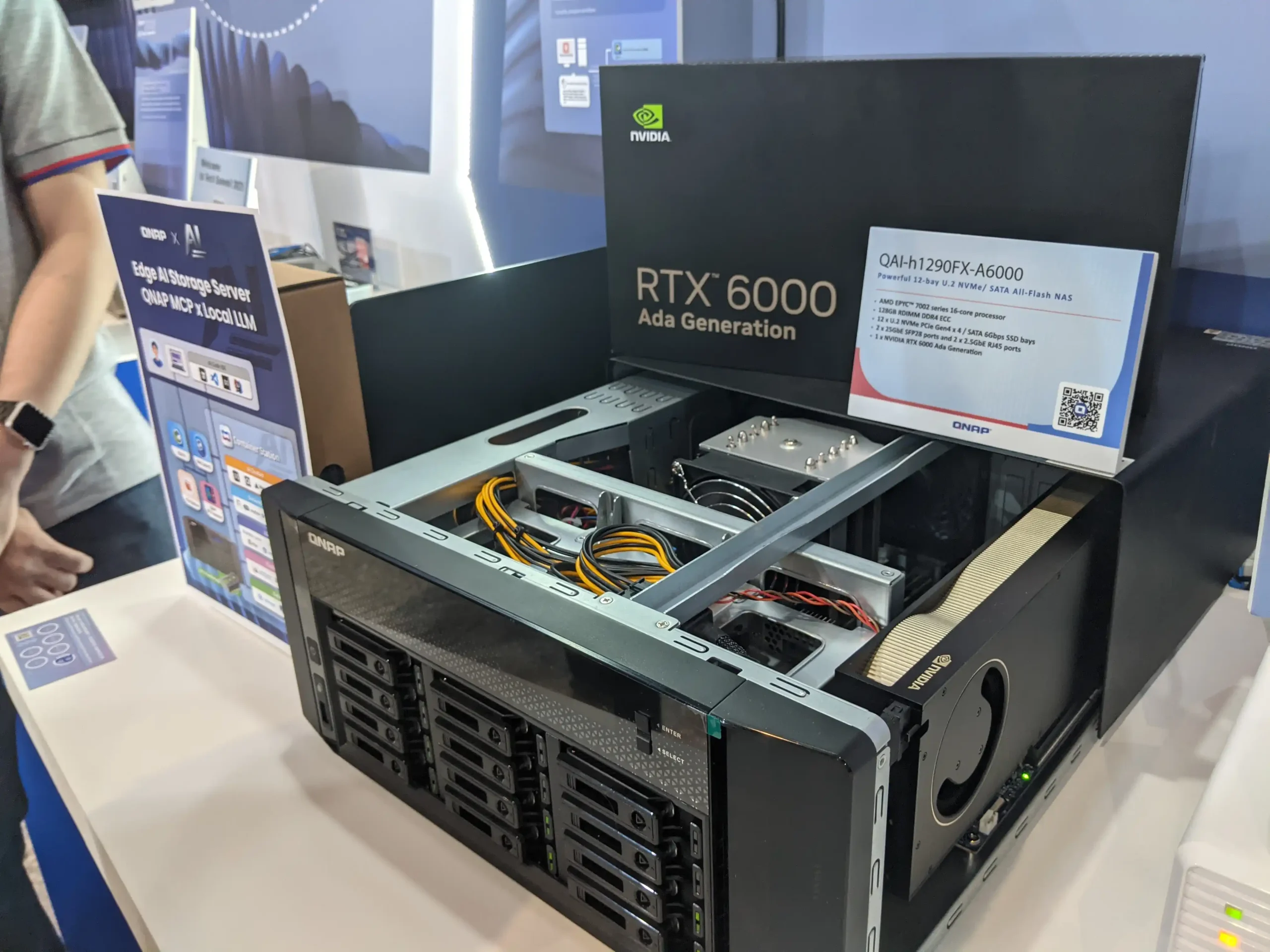
Internally, the unit can be configured with either two NVIDIA RTX 4000 Ada GPUs or a single RTX 6000 Ada, providing the CUDA cores and VRAM necessary to host and serve advanced AI models such as DeepSeek, Qwen, Mistral, and LLaMA. These models are deployed using either Virtualization Station or Container Station, and are tightly integrated with QNAP’s AI-enhanced Qsirch engine. The device supports RAG-based natural language search, allowing users to query locally stored documents using plain language and receive contextual, reference-backed answers.
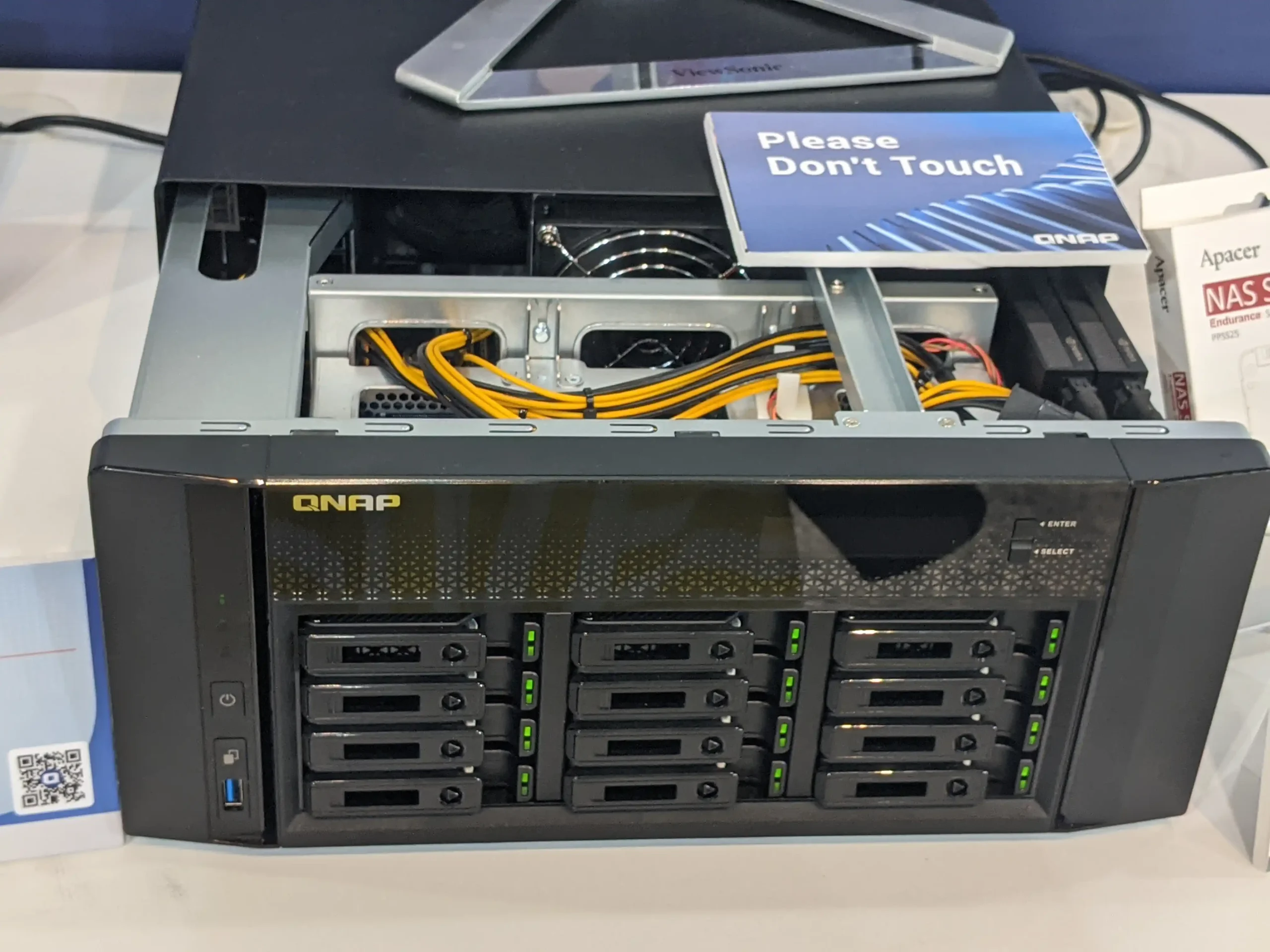
The system includes standard QNAP management utilities as well as GPU monitoring, model download management, and resource orchestration tools accessible via a centralized interface. For businesses with compliance obligations or sensitive data workloads, this appliance offers a CapEx-friendly AI solution that avoids data residency concerns and ongoing cloud inference costs.
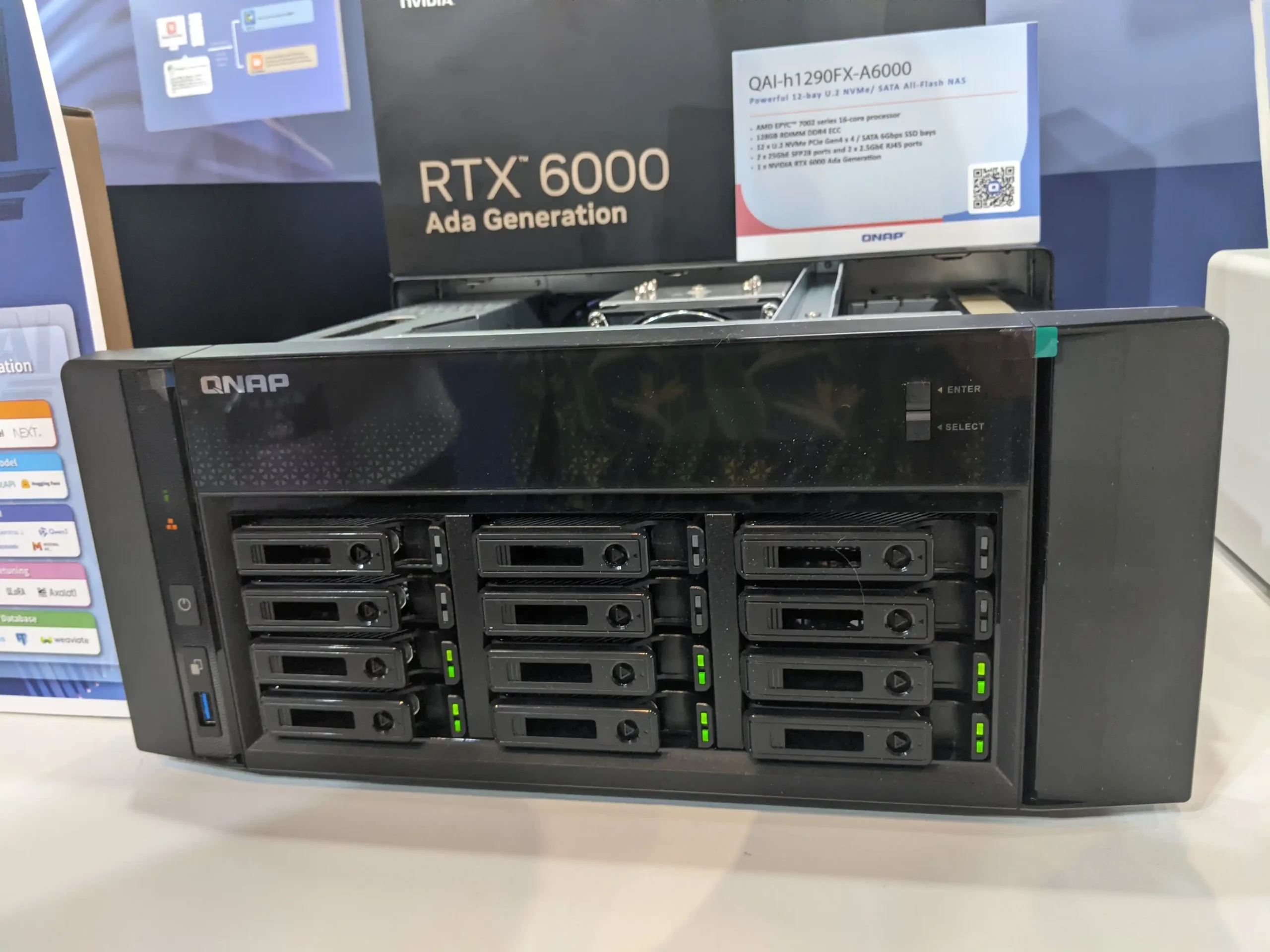
The QAI-H1290FX also supports FileTiers, QuTS hero for ZFS storage management, and can offload archived or low-priority data to myQNAPcloud One or external NAS systems, maintaining high-speed access to AI-critical datasets on SSD or NVMe storage pools.
| Feature | Details |
|---|---|
| GPU Options | 2 x NVIDIA RTX 4000 Ada or 1 x RTX 6000 Ada |
| AI Model Support | DeepSeek, Qwen, Mistral, LLaMA, Gemma (via container or VM) |
| CPU / Memory | Not officially specified (high-performance platform) |
| AI Capabilities | RAG search integration, LLM inference, local AI pipeline |
| Storage Management | QuTS hero (ZFS), inline compression, snapshots, FileTiers |
| Software Stack | Qsirch AI module, Docker, Virtualization Station |
| Use Cases | On-prem AI inference, enterprise document search, private LLM hosting |
QNAP SSD 700 Series – Enterprise E1.S NVMe SSDs for NAS and Flash Expansion
The QNAP SSD 700 Series introduces enterprise-grade E1.S NVMe SSDs aimed at delivering consistent performance, endurance, and reliability for QNAP NAS and expansion enclosures, particularly those supporting U.2, E1.S, or hybrid SSD configurations. These drives are designed for deployment in all-flash NAS environments, as well as tiered storage setups requiring high IOPS for AI, virtualization, or database workloads.
Built on PCIe Gen 4 x4 architecture, the SSD 700 drives deliver random read performance up to 900K IOPS, with write performance up to 60K IOPS. These metrics are tuned for mixed-use environments with a DWPD (Drive Writes Per Day) rating of 1, balancing endurance and cost-effectiveness for sustained 24/7 operations.
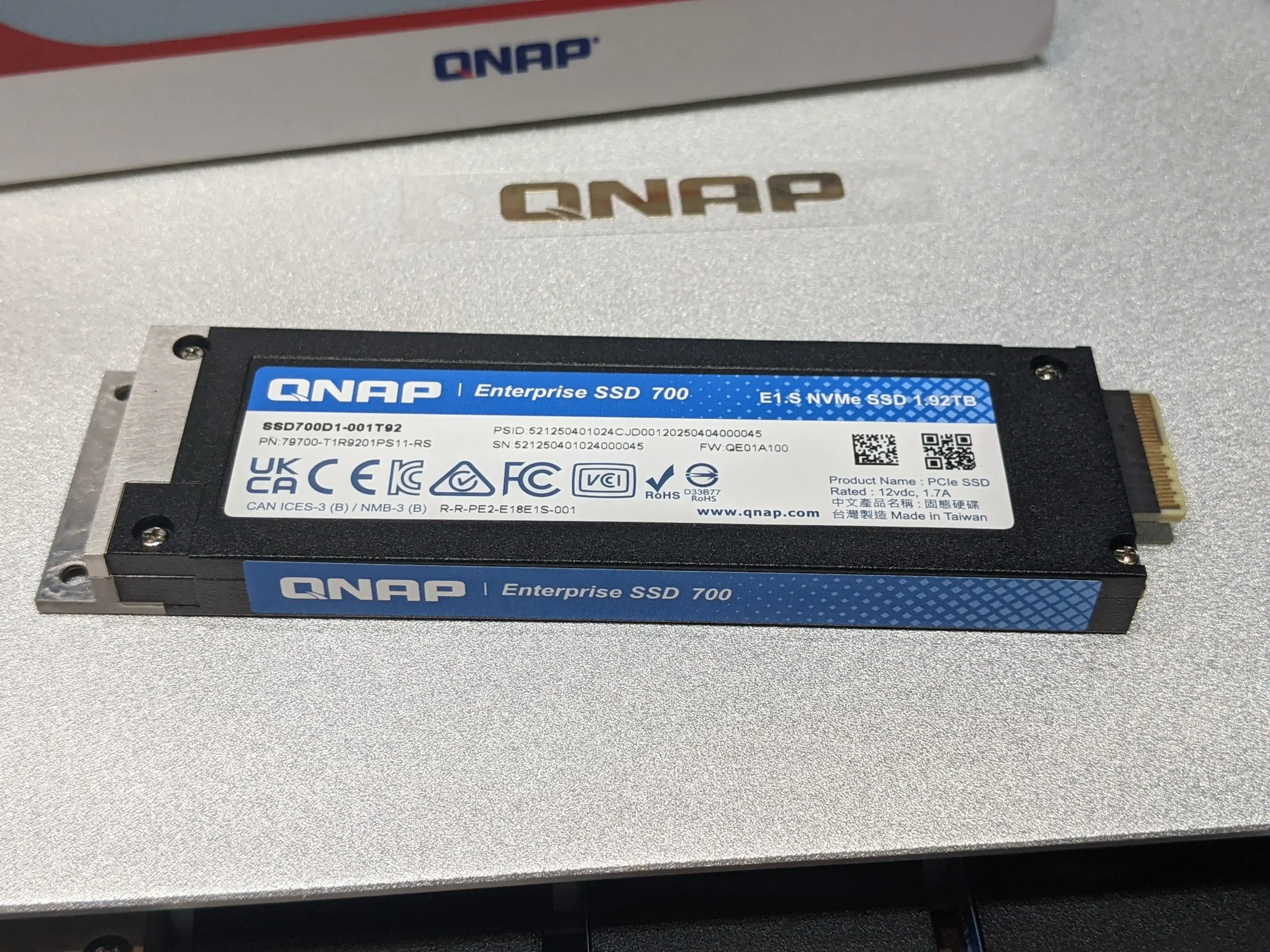
Drives are available in 1.92TB and 3.84TB capacities, with a 9.5mm E1.S form factor, making them compatible with newer QNAP NAS platforms such as the TS-h1655XeU-RP and TS-h974TX. They include Power Loss Protection (PLP) to protect in-flight data during unexpected shutdowns, and support TCG Opal 2.0 for hardware-level encryption and secure data sanitization.
These drives are warrantied for 5 years, aligning with typical enterprise storage lifecycles, and are designed to operate reliably under sustained load and elevated ambient temperatures often found in densely populated NAS enclosures.
| Feature | Details |
|---|---|
| Interface | PCIe Gen 4 x4 |
| Form Factor | E1.S, 9.5mm height |
| Capacities | 1.92TB, 3.84TB |
| Performance | Up to 900K IOPS (read), 60K IOPS (write) |
| Endurance | 1 DWPD |
| Data Protection | Power Loss Protection, TCG Opal 2.0 |
| Use Cases | All-flash NAS, tiered storage, AI caching, VMs, database acceleration |
| Warranty | 5 Years |
QXP-T52P – Dual-Port Thunderbolt 5 Expansion Card for High-Speed NAS Connectivity
The QXP-T52P is QNAP’s new Thunderbolt 5 expansion card, designed to bring next-generation 80Gbps connectivity to compatible QNAP NAS systems with available PCIe Gen 4 x4 slots. This card allows NAS units to directly interface with high-bandwidth creative workflows, fast data ingest setups, or multi-user collaborative environments that rely on low-latency throughput.
The card is built around the Intel JHL9580 Thunderbolt 5 controller, and provides 2 x Thunderbolt 5 (USB-C) ports, each capable of handling up to 80Gbps bi-directional bandwidth. It is backward-compatible with Thunderbolt 3, Thunderbolt 4, and USB4 hosts or accessories, ensuring broad interoperability with editing suites, external RAID enclosures, and high-speed JBODs.
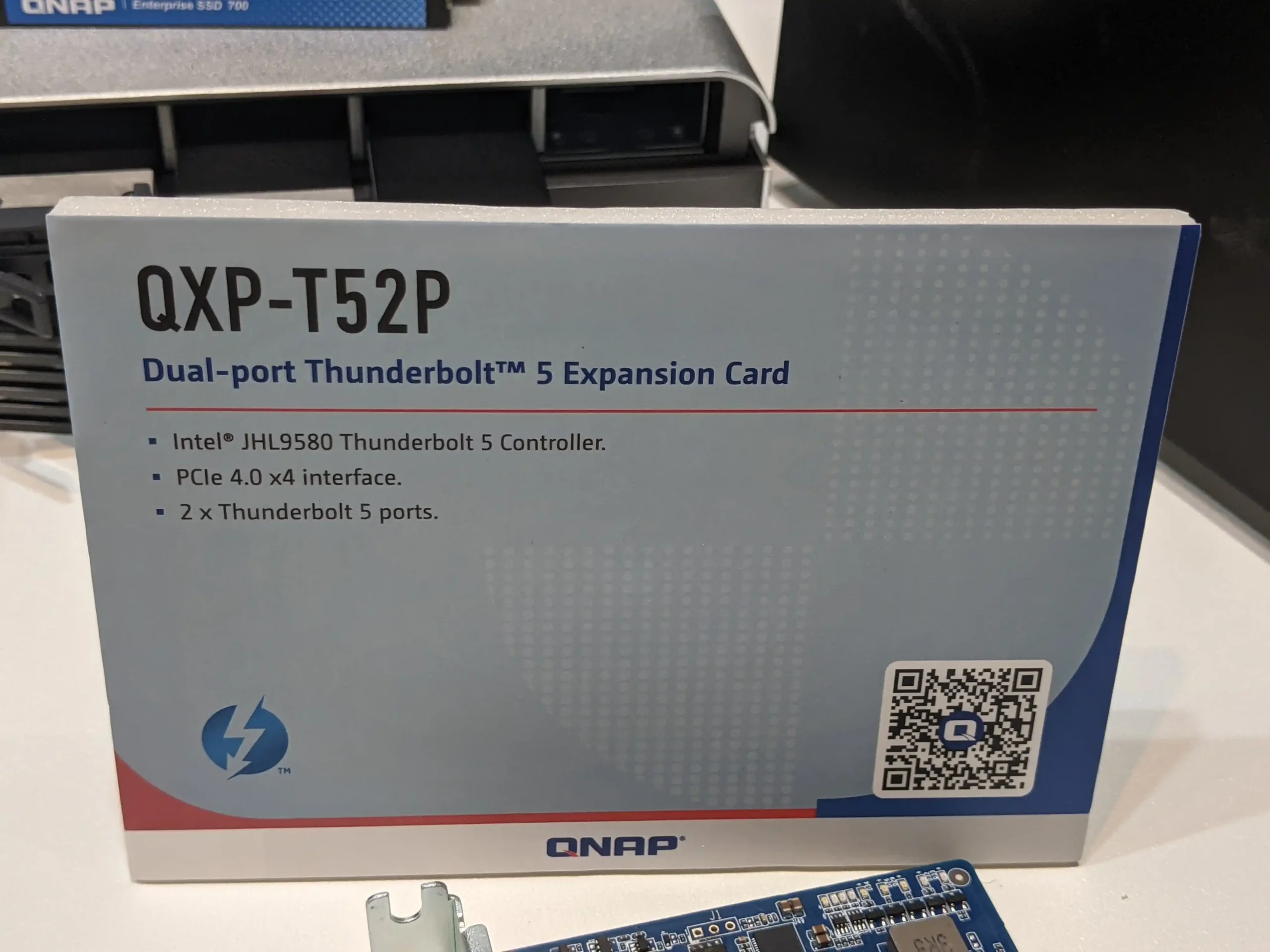
Installation is supported in QNAP NAS units equipped with PCIe Gen 4 support and appropriate cooling and power headroom. Once installed, the card enables DAS-style access to the NAS at ultra-high speeds, which is particularly beneficial for large file editing (4K/8K video), VFX production, and real-time content review.
The QXP-T52P is intended to complement QNAP systems such as the TVS-AIh1688ATX, which includes native Thunderbolt 4 ports but can expand further using this card, creating up to four Thunderbolt connections for simultaneous editing stations.
| Feature | Details |
|---|---|
| Interface | PCIe Gen 4 x4 |
| Thunderbolt Ports | 2 x Thunderbolt 5 (USB-C) |
| Controller | Intel JHL9580 |
| Max Bandwidth | 80Gbps (bi-directional per port) |
| Compatibility | Thunderbolt 5/4/3, USB4, USB-C |
| Use Cases | NAS-to-workstation DAS, video editing, real-time data ingestion |
| System Requirements | QNAP NAS with PCIe Gen 4 slot and adequate cooling |
QVR Surveillance and TVR-AI200 – Unified VMS and Edge AI for Security Deployment
In the surveillance segment of the Tech Summit 2025, QNAP presented an expanded role for its video monitoring ecosystem, centered on the TVR-AI200 NVR appliance and an updated QVR Surveillance platform. These solutions aim to simplify system deployment, enhance video intelligence at the edge, and consolidate multi-site management under a single interface. The TVR-AI200 is a compact, standalone NVR that supports up to 16 IP cameras via built-in PoE+ ports. With a setup time of under 10 minutes and support for offline initialization, it is positioned as a rapid-deployment solution for retail chains, branch offices, and remote sites. Unlike standard NAS-based surveillance, this unit is dedicated solely to VMS tasks, running QVR Pro/Elite natively and optimized for AI-enhanced video analytics such as facial recognition, motion detection, and object tracking.
On the software side, the QVR Surveillance suite has received architectural and interface updates. Key enhancements include multi-channel event playback, real-time timeline navigation, and customizable recording profiles. New AI event triggers—such as virtual boundaries, unattended object detection, and license plate recognition—can be configured to trigger alerts or backups through myQNAPcloud One or secondary NAS units. Additionally, QNAP highlighted its ongoing partnership with Network Optix, enabling full support for Nx Witness VMS across QNAP NAS models. This integration allows QNAP devices to host both the video management software and the recorded footage, reducing the need for external VMS servers and helping small-to-medium deployments consolidate hardware. Storage management is enhanced with FileTiers, ensuring high-frequency footage stays on SSD or U.2/NVMe volumes, while archival video is moved automatically to slower disks or cloud targets. This helps reduce costs while maintaining fast access to recent recordings.
| Feature | Details |
|---|---|
| Model | TVR-AI200 |
| Camera Support | 16-channel IP (native), via 16 x PoE+ ports |
| Setup | Plug-and-play, offline deployment supported |
| AI Features | Facial recognition, motion detection, object tracking |
| VMS Compatibility | QVR Pro / Elite, Nx Witness VMS (via partnership) |
| Storage Tiering | FileTiers integration (local SSD/cloud archival workflows) |
| Deployment Targets | SMB, multi-branch retail, industrial surveillance, remote sites |
The QNAP Tech Summit at Computex 2025 presented a broad and structured update to QNAP’s product lineup, with a clear focus on high-speed connectivity, AI integration, and scalable infrastructure. Standout hardware included the TVS-AIh1688ATX, which combines U.2 SSD support and Thunderbolt 4/5 expansion for creative workflows, and the QAI-H1290FX, positioned as a turnkey edge AI platform for private LLM deployment. In the enterprise space, the ES1686dc R2 demonstrated QNAP’s continued investment in dual-controller, high-availability storage for critical workloads.
On the software side, the introduction of QUTS Mega signals a shift toward large-scale, clustered storage, while the enhanced Hybrid Backup Center and myQNAPcloud One provide unified data protection with support for immutability and real-time monitoring. Surveillance applications were also refined with the launch of the TVR-AI200 and expanded support for AI-based event detection and third-party VMS integration. Overall, QNAP’s announcements reflect a strategy focused on modularity, multi-tier storage, and integration across local and cloud environments—delivering solutions for both general-purpose NAS users and specialized professional deployments.
📧 SUBSCRIBE TO OUR NEWSLETTER 🔔
🔒 Join Inner Circle
Get an alert every time something gets added to this specific article!
This description contains links to Amazon. These links will take you to some of the products mentioned in today's content. As an Amazon Associate, I earn from qualifying purchases. Visit the NASCompares Deal Finder to find the best place to buy this device in your region, based on Service, Support and Reputation - Just Search for your NAS Drive in the Box Below
Need Advice on Data Storage from an Expert?
Finally, for free advice about your setup, just leave a message in the comments below here at NASCompares.com and we will get back to you. Need Help?
Where possible (and where appropriate) please provide as much information about your requirements, as then I can arrange the best answer and solution to your needs. Do not worry about your e-mail address being required, it will NOT be used in a mailing list and will NOT be used in any way other than to respond to your enquiry.
Need Help?
Where possible (and where appropriate) please provide as much information about your requirements, as then I can arrange the best answer and solution to your needs. Do not worry about your e-mail address being required, it will NOT be used in a mailing list and will NOT be used in any way other than to respond to your enquiry.

|
 |
Beelink ME Pro NAS Revealed
Best SOLID STORAGE NAS of 2025
Should You Worry About the NanoKVM Hidden Microphone?
Best Cheap NAS of 2025
Minisforum MS-02 Ultra - WHO IS THIS FOR??? (The First 48HRs)
Why People Use TrueNAS, UnRAID and Proxmox to Turnkey NAS (Synology, QNAP, etc)
Access content via Patreon or KO-FI
Discover more from NAS Compares
Subscribe to get the latest posts sent to your email.


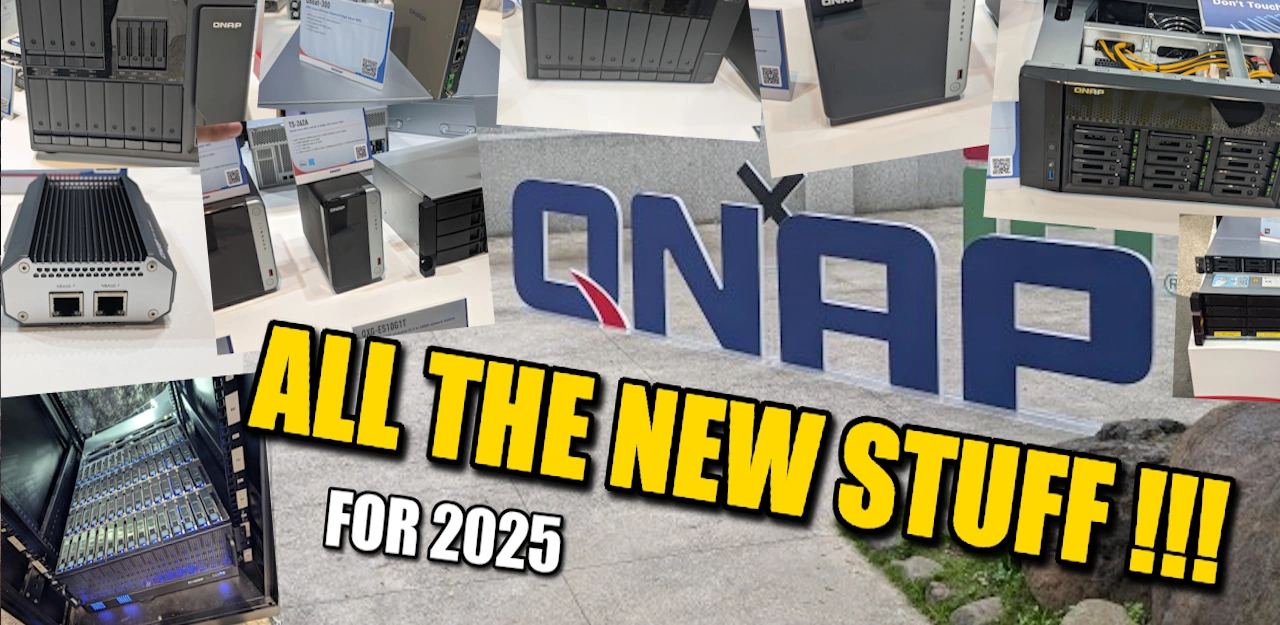

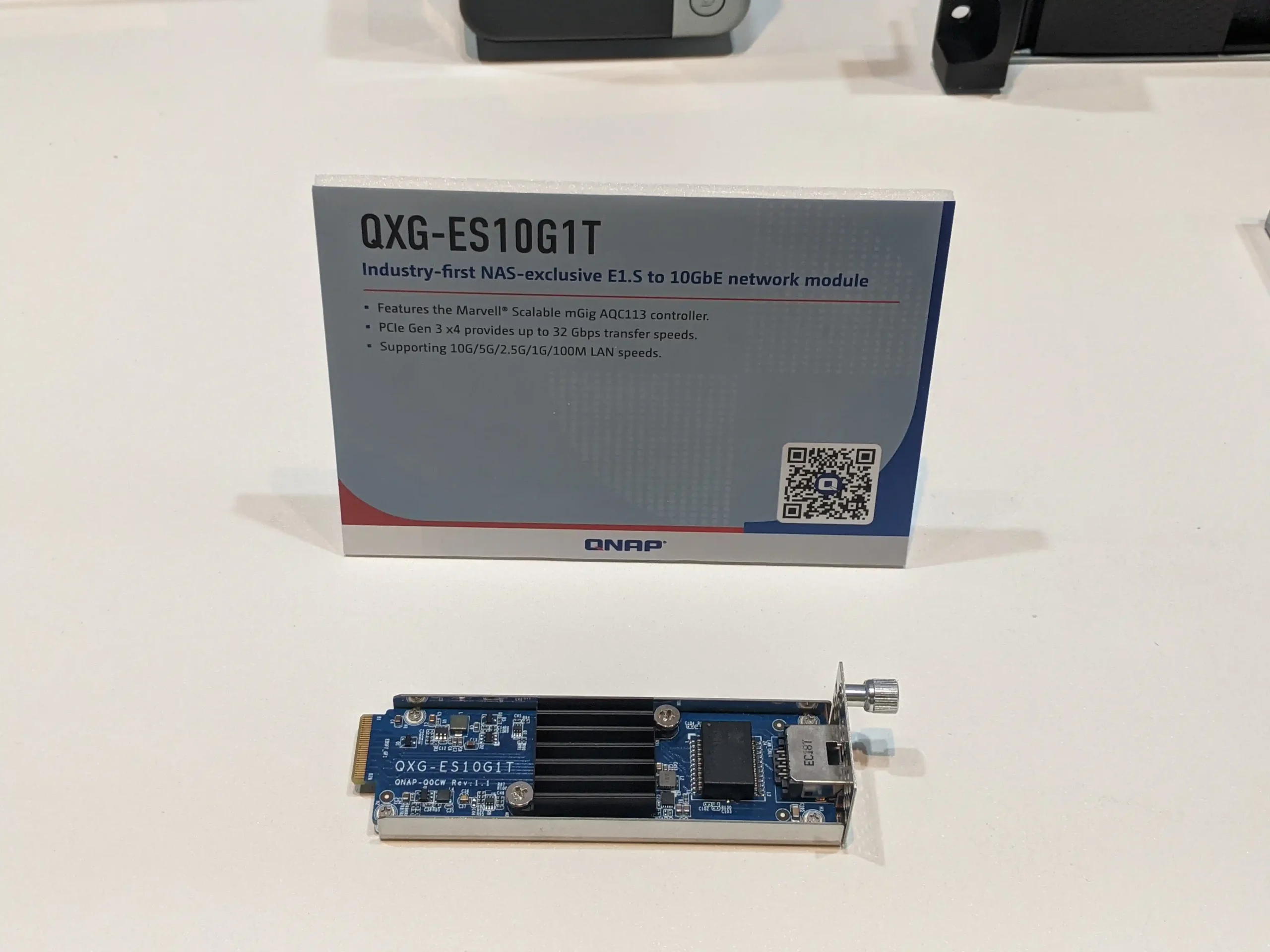
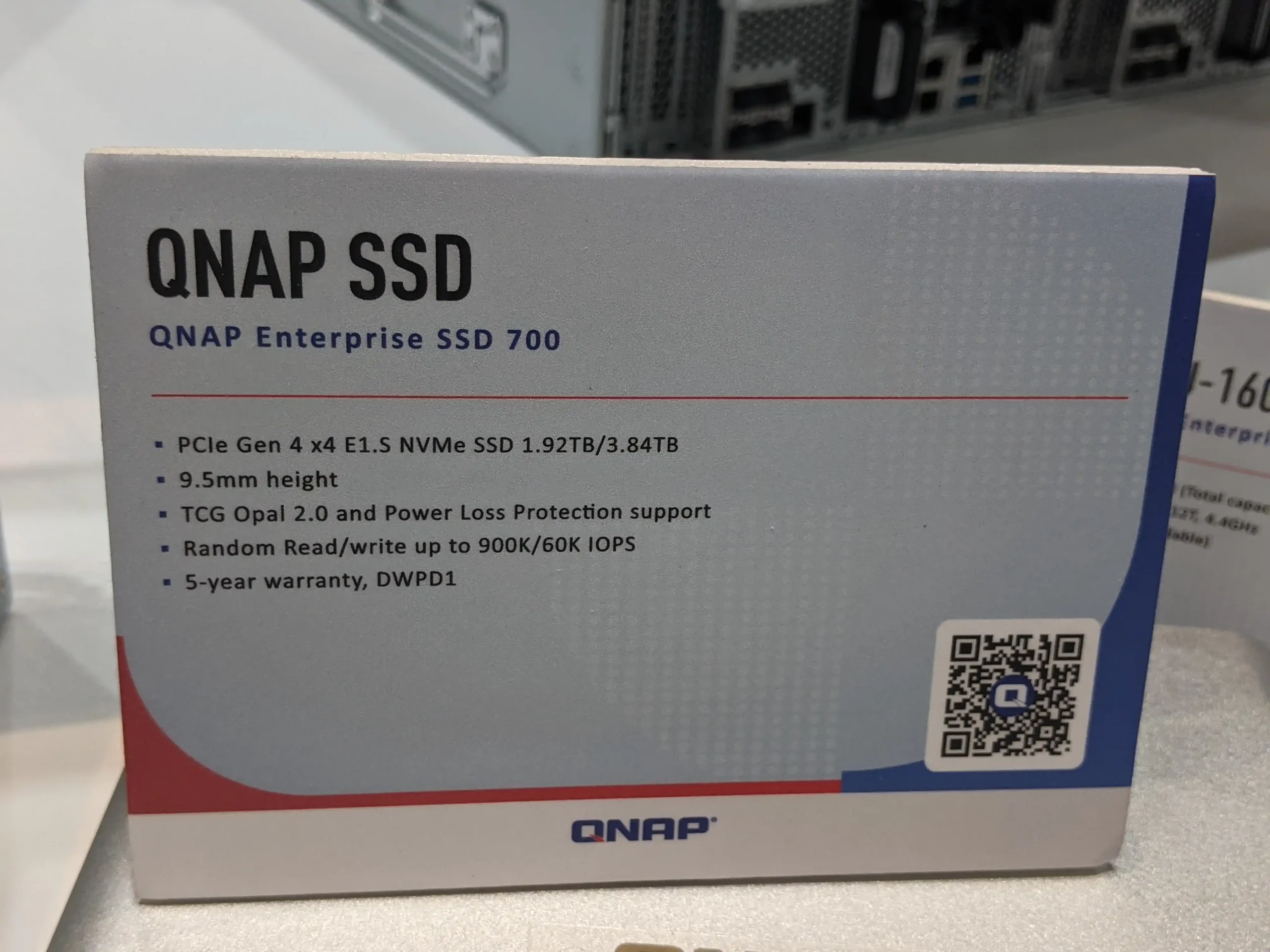
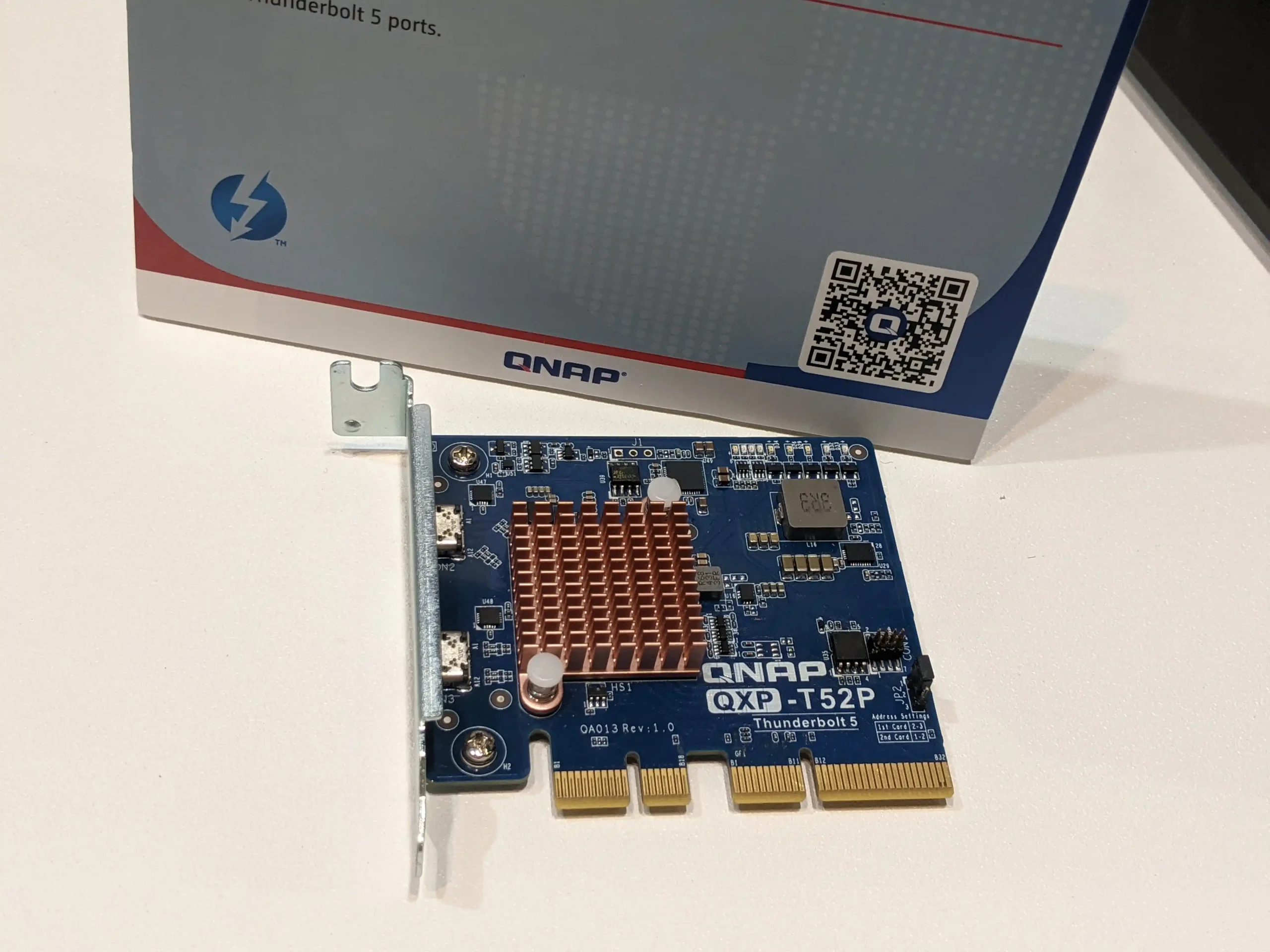



DISCUSS with others your opinion about this subject.
ASK questions to NAS community
SHARE more details what you have found on this subject
IMPROVE this niche ecosystem, let us know what to change/fix on this site